Home Blog Presentation Ideas How To Do a Proper Thesis Defense Using the Right PowerPoint Presentation

How To Do a Proper Thesis Defense Using the Right PowerPoint Presentation
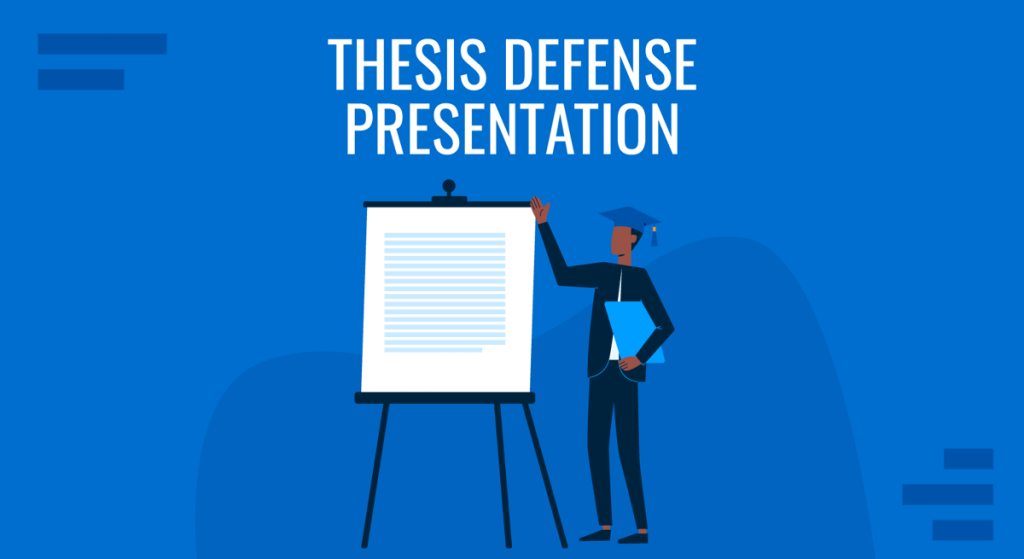
Writing a thesis is stressful, but preparing an oral defense can be even more painful. But it doesn’t have to be; with proper preparation and a good presentation, you will be able to better equip yourself comes time to present your thesis defense.
But what makes a good thesis defense?
A proper presentation helps you with your thesis defense because it helps you capture the panels’ attention and gives you cues and reminders on what to say as well.
It also helps keep your data organized while visually looking good and provides a flow structure for the rest of your presentation.
In today’s article, we will be giving you The Right PowerPoint Templates for Your Thesis Defense and a powerful outline composed of best practices and layouts specifically designed to help you defend your thesis in both written and oral presentations.
In the next segments of this article, we’ll walk you through the most feasible process on how to ace this kind of presentation.
Let’s dive into the outline of what makes a great thesis defense.
Thesis Defense Overview
Similarities.
- Type of Degree
Thesis and Dissertation Distinction Varies on Location
Three most common thesis defense myths, how to use chatgpt to structure your thesis.
- Introduction
- Literature Review
- Methodology
- Acknowledgements
- Questions and Answers
- Contact Information
- Tips During Your Oral Defense
- More Quick Tips on How to Present
A thesis defense is composed of two parts – a thesis and a defense.
The thesis, according to Grad School Hub , represents a student’s collective understanding of his or her program and major.
Universities often include a thesis in every course as one of the final requirements to earn a particular graduate or postgraduate degree.
The thesis, however, isn’t just a mere requirement.
It helps the students to grow out of their shell from their respective discipline and give them the opportunity to present all the findings of their study.
Moreover, some people think a thesis is just a long essay, but it’s not. Unlike an essay, a thesis needs to assert something.
This can be considered one of the most crucial research documents that a student makes during their academic schooling .
On the other hand, defense is the presentation of the pieces of evidence to support and prove your research.
It’s the most essential part of the thesis process.
Your presentation has to be prepared to answer questions from members of the committee and any other panel present, and it’s your job to convince them and defend your thesis with ample proof.
Prior to presenting, you have to carefully determine what appropriate evidence should be presented before the panel, depending on what thesis you have to defend.

Thesis and Dissertation Distinguished
A thesis or dissertation is usually required to complete a particular graduate degree. These two words are often used interchangeably by most students when referring to research studies.
But while being almost similar in format or structure, it’s worth noting that they have significant differences that set them apart from each other.
The very reason why thesis and dissertation are treated the same is that these two are both extensive papers. Not just merely long essays like what others are claiming.
Both of these papers are extensive. This is why students are given ample time, usually the entire last semester of the last year of study, to complete all the requirements and finally acquire their degree.
With regards to structure, both papers are very similar with few differences.
Differences Between Thesis and Dissertation
One of the significant differences between the two is to whom the paper is assigned. A thesis is usually required for those students earning a bachelor’s or master’s degree. While a dissertation is for those, who want to obtain a doctorate degree.
However, not all students taking a master’s degree are required to make a thesis. Prior to their enrollment, they have been given a choice of whether they’ll go for a non-thesis program or with a thesis.
Those who have a plan to escalate their degree to a doctorate eventually should take the path of a thesis. This is to prepare themselves for a more extensive dissertation requirement as doctorate students. Otherwise, they will be only limited to earning a master’s degree.

But above all, the most significant difference between the two papers is the purpose for which it is written.
A thesis, like what has been mentioned above, is being done by students obtaining a bachelor’s or master’s degree and has the purpose of testing their understanding of the discipline they’re engaged with.
A thesis is focused on obtaining technical expertise.
On the other hand, a dissertation is made for students to come up with an original study that other researchers haven’t already studied.
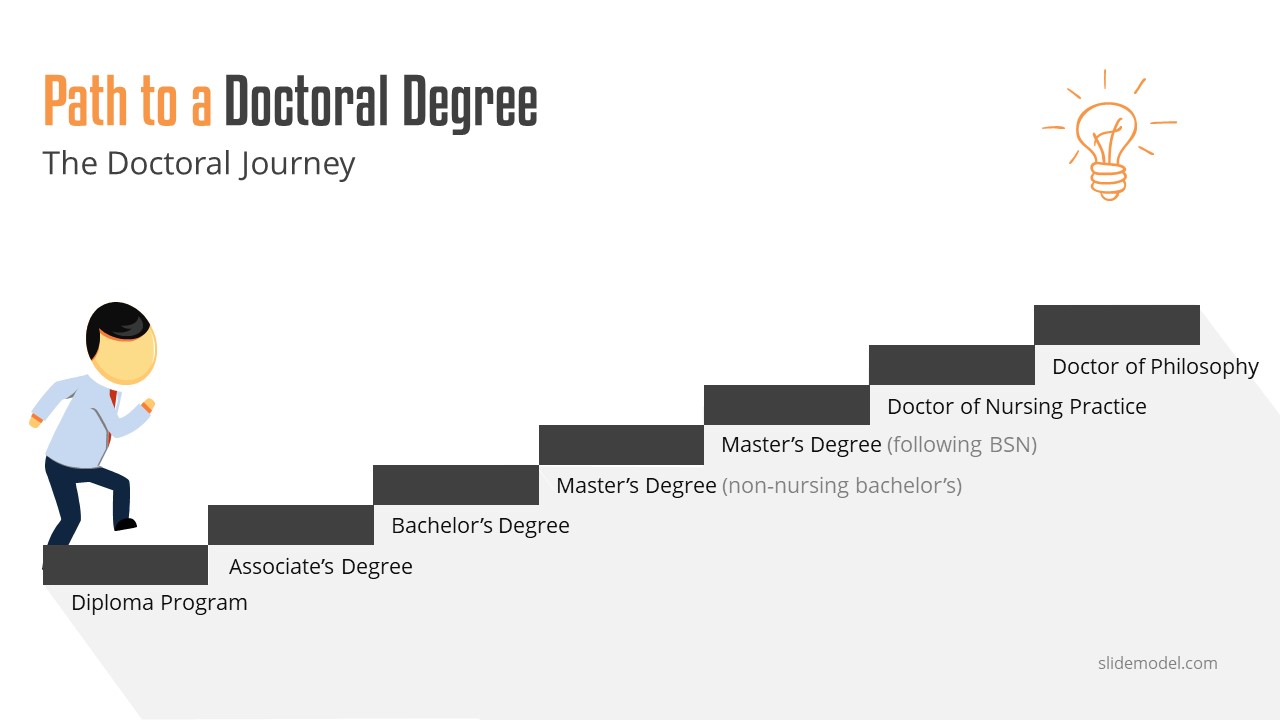
USA: In the United States of America, they consider a thesis shorter than a dissertation. In fact, aside from being a requirement to graduate in college, a thesis is now also inculcated in master’s degree programs. And since the dissertation is more extensive, the thesis is treated as preliminary in gaining a doctorate degree.
Europe: The distinction between the two papers is almost opposite to that of the USA. In Europe, a dissertation is only a broader research study from a post-graduate program and not the making of original research. Instead, educational systems in the said continent treat the doctoral thesis as a more elaborate paper writing.
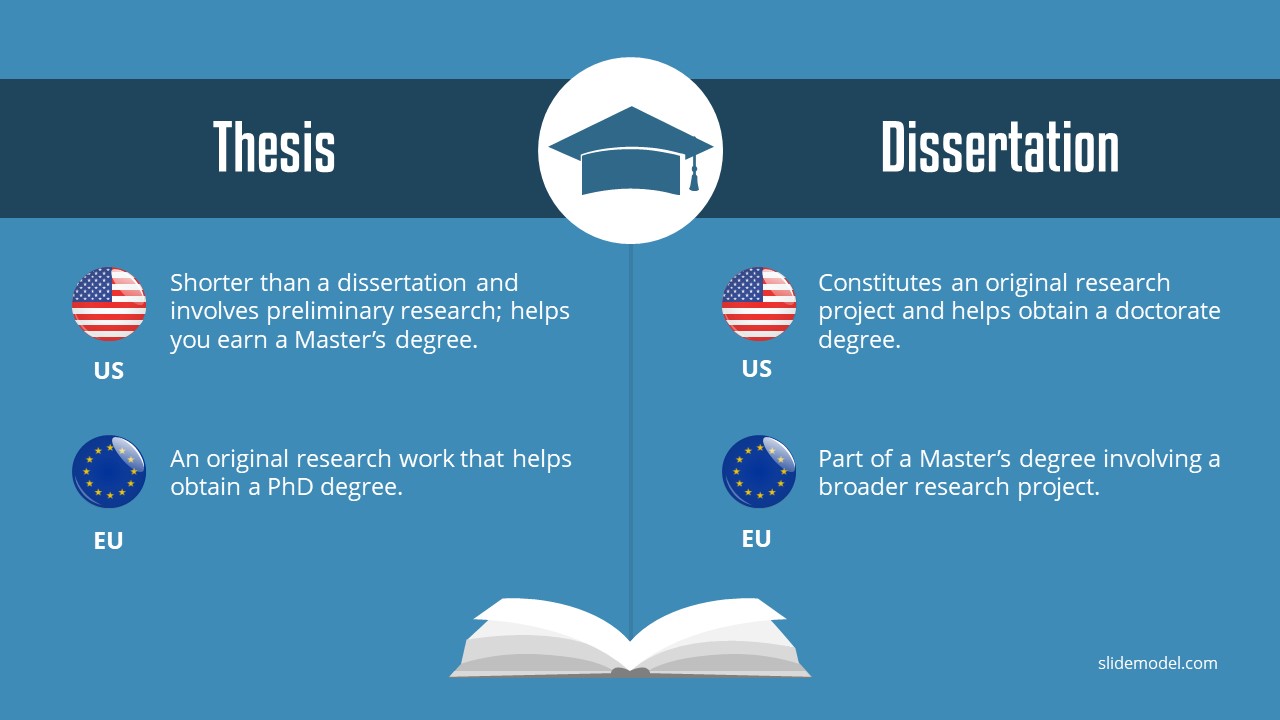
The difference between a thesis and a dissertation might not seem that big, but it’s important that we know what makes them different.
If your upcoming defense gives you pressure and uneasiness, it could be cause you are not sure what to expect. Today we will dispel three common thesis defense myths that will help you be more confident in your presentation.
“Answer all the questions correctly. Otherwise, your thesis won’t get approved.”
You are expected to have a focus on your research.
That being said, you have to study each part of your thesis, every detail, and even your sources.
You have to study and practice how to effectively deliver your presentation.
But don’t overthink to the extent that you’re stressing yourself to know everything perfectly.
Don’t overstress if you can’t answer one of the questions, this doesn’t necessarily mean the committee won’t approve your thesis.
You should know that research is a continuous study.
So you should expect that your committee will always be able to find a gap in your study to fill in future related research .
So in times you don’t exactly know the answer, admit it, and you’ll learn as they give their sides or suggestions.
Making up an answer will only displease your committee, so it’s to be upfront, honest, and transparent.
“The committee is just there to find holes in your study. They don’t care about you.”
One of the typical descriptions students have of the committee is that they are just there to poke holes in your thesis.
Going in with this perspective makes standing before them a nerve-wracking experience.
They’re not your enemy.
In fact, they are there to help you polish your study.
They might challenge you with difficult suggestions and tricky questions.
In the end, they will walk you through the process to come up with better results that won’t only benefit you but also your research.
They care about you and your study, and they’re ultimately there to make your thesis and the research better. Separate yourself from your work look at it objectively, and don’t take their comments personally .
“If your thesis defense isn’t successful, you have to start your thesis all over again”
An unsuccessful defense is one of the worst-case fears most students have.
One thing that you should be aware of is when you aren’t able to please your committee, you don’t need to start a new thesis again or go back to square one with your existing paper.
It’s unusual that your committee will ask you to change your topic and start from scratch again.
The fact that you’ve been permitted to defend your study means your research is almost complete.
They might suggest further details or ask you for minor revisions, and that’s normal.
But overall, you need to go into this defense thinking that your presentation will be successful. Otherwise, you are already setting yourself up for failure with the wrong mindset.
Remember that positive thoughts attract positive results.
Thesis Defense Presentation Structure and Slides Content
We can use language learning models like ChatGPT to help us curate the structure of our thesis presentation. Let’s see a step-by-step solution on how to apply this.
Step 1: Define the thesis topic and research questions
You can set the environment for ChatGPT to work by explaining what your thesis is going to cover and which specific questions you aim to address through the course of that document. This gives ChatGPT the context from which it shall formulate the structure. A prompt can be written like this:
“Take the role of an academic professional who shall help me to write my thesis. This thesis is going to cover the topic of (insert topic), and through its course, I want to answer these questions: Question 1 – Question 2 – Question 3 – Consider this information as the starting point for this chat.”
Step 2: Ask for an outline
With the previously provided information, ask ChatGPT to generate an outline for your presentation. If some of the points listed in the output don’t convince you, then chat with the interface until you reach a final outline. Then, ask to elaborate on each specific point for information or cues you may have overlooked.
Step 3: Ask ChatGPT which content should you place per slide
Instead of debating how are you going to trim your thesis into a presentation format, ask ChatGPT to do the decision process for you. You can be as specific as asking how many words per slide, how many slides should the presentation have, if you need any visual element, etc.
N.B.: We don’t recommend using ChatGPT to retrieve academic references as, in some cases, it can provide faulty results. You can ask if any facts on this presentation need to be checked or similar questions. ChatGPT is a powerful tool, but it shouldn’t be considered a bible, so be extra cautious about grabbing content directly from its outputs.
1. Title Page
This slide should contain the information that is provided on the title page of your hard copy . Here is an example of title page or cover slide for your title defense or thesis presentation.

- The title of your research paper
- Where you are studying
- Name and details of your course
- Name of Adviser
2. Introduction Slide
Your introduction slide should provide the committee with an idea of the following:
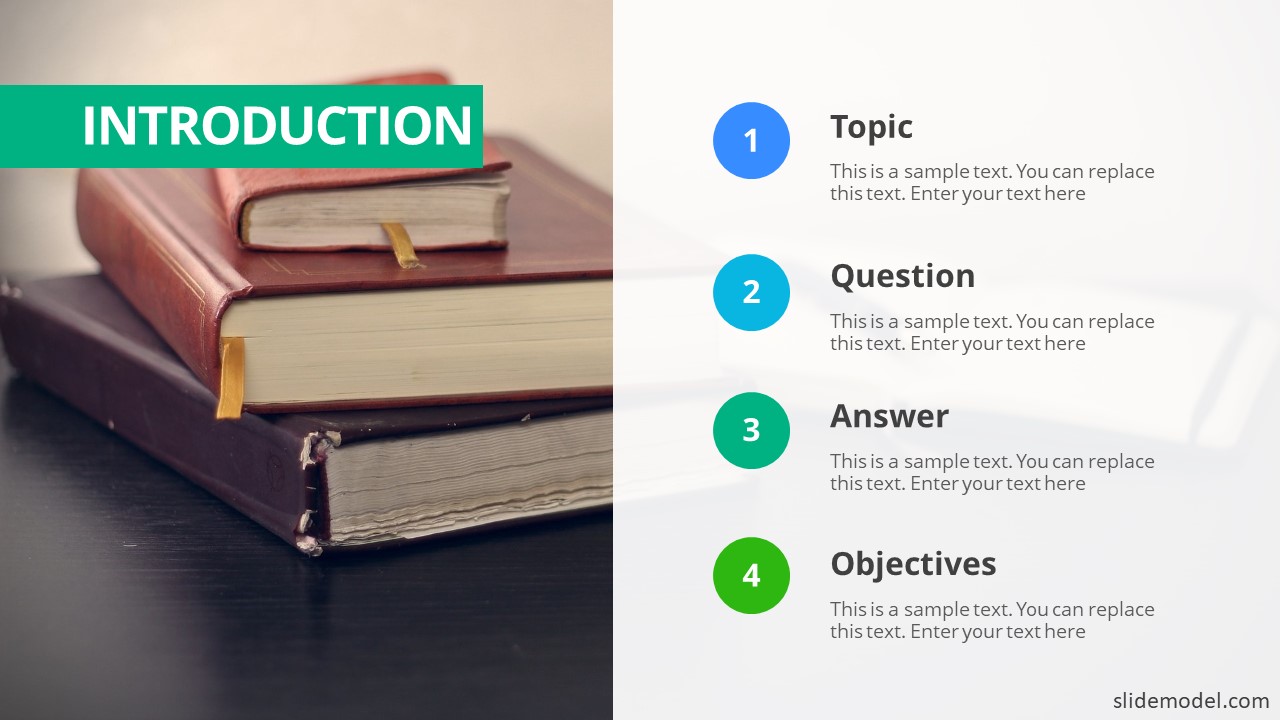
- What is the topic area that you are investigating ?
- What are the specific research questions that you set out to answer?
- Why is this question important to answer?
- What were the objectives of your research?
3. Literature Review Slide
It’s not necessary to cover everything that’s currently understood in the available literature. You may want to present the following content under a Literature Review slide:
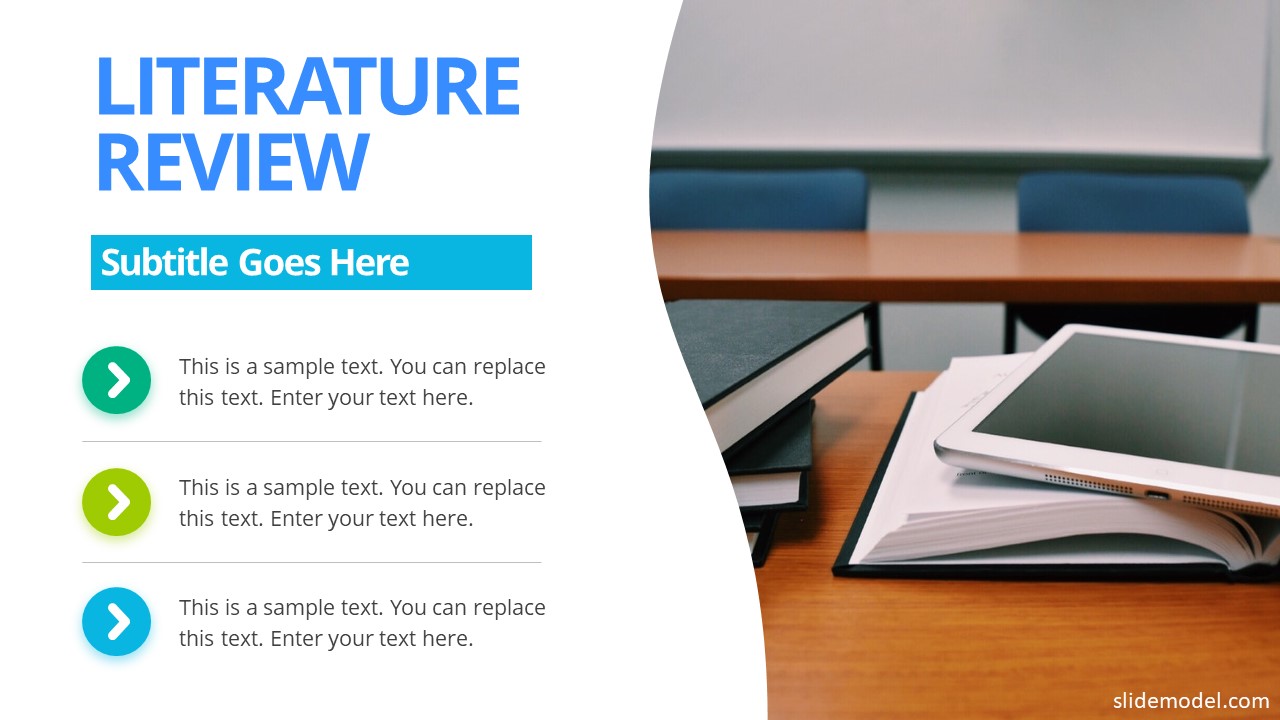
- Relevant current research that is close to your topic
- Different theories that may apply to your specific area of research
- Areas of weakness that are currently highlighted
4. Methodology Slide
Make sure to touch the factors below within your process, and include the following in the Methodology slide:

- The type of study you have conducted: qualitative, quantitative, or mixed
- The methods that you chose and why
- Details of the population, sampling methods, and other information
- Provide information regarding how you have analyzed the data that you have collected
5. Results Slide
This part should give the committee/audience a good understanding of what you’ve discovered during your research. The statistics & results slide could include the final results of your analysis, here is an example:

- An overall description of the data that you collected during your research
- The results of the analysis that you have done on that data
- What were the most significant findings from your data
6. Discussion Slide
Highlight here the meaning of the findings in relation to your discipline program and the research that you have done:
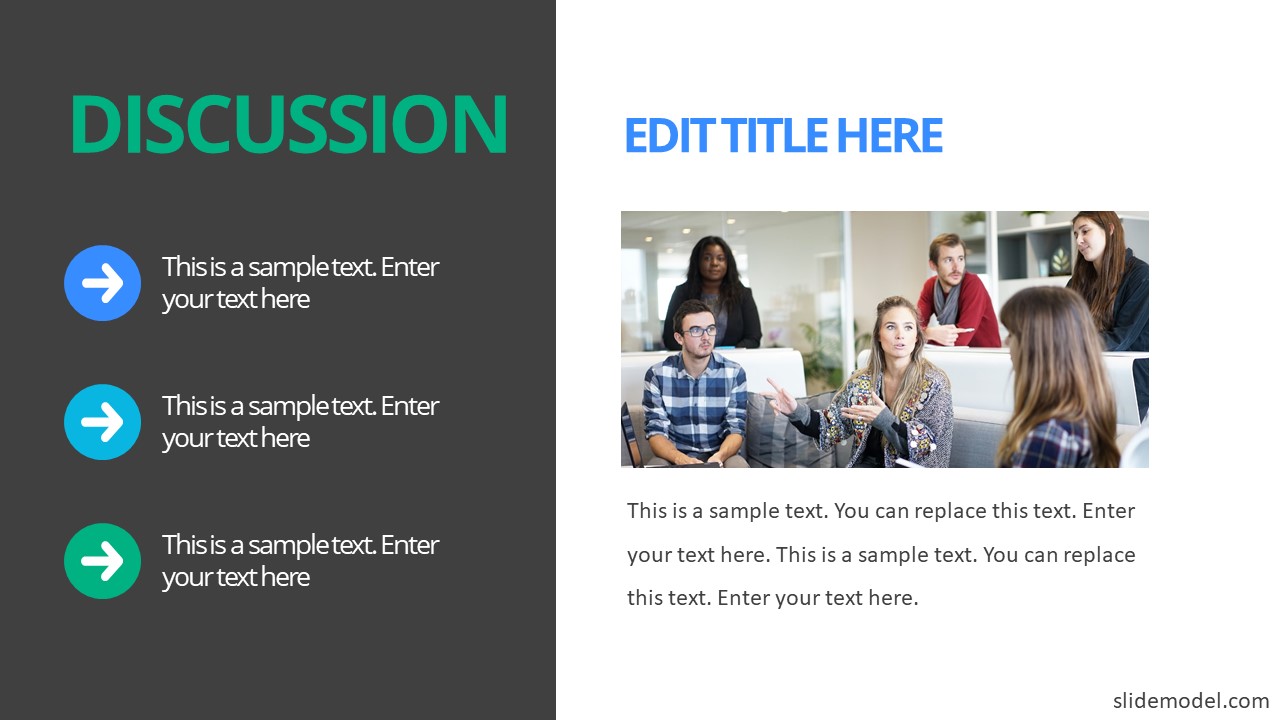
- What are the major findings, and what do they mean with regard to your research
- How do these findings relate to what others have found in the past
- How can you explain any unusual or surprising result
7. Conclusions Slide
You have to end your presentation with a conclusion summarizing all that you have found within your research. Here is an example of a Conclusion slide in a Thesis presentation:

- Restate your research questions
- Show how your results answer these questions
- Show what contribution you have made
- State any limitations to the work you have done
- Suggest future research
- Make any recommendations
See Also: How to Create a Great Investors Pitch Deck and Close the Deal
8. Acknowledgements Slide
Express gratitude to your advisor, committee members, peers, and others who supported your research journey. This slide provides a moment to acknowledge the collaborative nature of academic work.
9. Questions and Answers Slide
Dedicate a slide for audience questions at the end of your presentation.
Encourage engagement by inviting questions from the audience.
Be prepared to provide clear and concise responses to inquiries.
10. References Slide
Include a slide listing your cited sources throughout your presentation.
Use a consistent citation style (APA, MLA, Chicago, etc.).
The References slide demonstrates your thorough engagement with existing literature.
11. Contact Information Slide
If you’re open to further inquiries or collaborations, consider adding your contact information.
Include your email address or relevant professional social media handles.
How to use SlideModel AI Presentation Maker for your Thesis Presentation
If you want to save hours of manual time, you can leverage AI tools to make your thesis presentation. The best part of integrating AI tools into our workflow is that we can pair them to get even better results than we expected. With SlideModel’s AI presentation maker , users can create an entire slide deck by introducing these variables:
- Topic of your thesis
- Number of slides to include in your thesis presentation
- Outline checkup
And that’s it! Download the AI-generated presentation in PPTX format or for Google Slides, and edit it if you require adding some extra content. The core elements are already done, and you can save countless hours of hard work.
Tips During Your Oral Defense!
Review your materials.
Even if you already feel confident with your upcoming presentation, you still need to review your materials.
You can bring the hard copy of your thesis with you during the defense, but you don’t want to get lost in your presentation when you forget some specific details and have to scan your papers.
You should know your paper in and out.
Rehearse Your Presentation
It’s not wrong if it sounds like a script when you speak in your oral defense. It’s expected and understandable.
You need to practice your presentation, especially when there’s a time restriction given to every presenter.
You only need to prepare enough slides that would fit your time limit. A hundred slides aren’t suitable for a 15 to 20-minute presentation, nor 10 slides for an hour of defense.
Your rehearsal will be more effective if you practice it in front of an audience.
Note: You will experience complete silence in the defense room. You might feel awkward because, most of the time, you’re the only one speaking out loud. This is completely fine, and it’s something you should practice in rehearsal should you be afraid.
Narrow the Presentation of Ideas
Regarding your slides, you don’t have to include everything that’s in your paper. You should narrow down your ideas to the main points and the most important details, such as the statistics and findings.
If the members of your committee think you lack details or they want to hear a further explanation, they won’t hesitate to ask you.
Prepare for the Unexpected Questions
The panel tends to challenge the presenters, usually through some hard questions.
Its aim is how well do you you have done your research and how prepared you are.
But as long as you know the ins and outs of your paper, you shouldn’t lose your confidence regardless of which questions they ask.
Just keep in mind that what you’re saying in your oral defense is not in conflict with what is written on the hard copy you provided them.
What To Do When You Don’t Know the Answer
If the committee asks you a question and you don’t know the answer, don’t make up a baseless answer.
Baseless means out-of-context answers or something without proof or backup.
How To Deal With The Nervousness
The committee expects you to be nervous. Of course, it’s normal.
However, one effect of being nervous is the changes in your behavior.
There’s a tendency for you’ll talk fast, which will make it hard for the committee to understand you.
It might also cause you to have a mental block.
So try to slow down. Take a deep breath.
Inhale, exhale. Remember to breathe!
It’s OK to pause, and it’s OK to take your time; it’s more important that the committee clearly understands what you are trying to articulate.
More Quick Tips on How to Present!
- Introduce yourself at the beginning
- Introduce the title of the presentation
- Don’t read your notes if possible
- Don’t speak too fast
- Put an emphasis on what you’re saying so you don’t sound monotonous
- Look at your adviser once in a while for possible signs
- Stand on the right of the white screen if you are right-handed so you can easily refer to the slide without giving your back to the committee
- Face the audience when you talk
- Keep an eye contact
- Make sure to keep attention to the reactions of the committee and don’t forget to react in turn
We hope you enjoyed this article on how to do a proper thesis defense and how to best prepare for one using proven tips and techniques to help you get through this. Hopefully, after your defense, you will be set as the one in your class to deliver an inspiring graduation speech for your peers. If you have value, please remember to share this article. We also recommend you read these Thesis Statement Examples for inspiration to create your own professionally.
1. MasterDoc PowerPoint Template
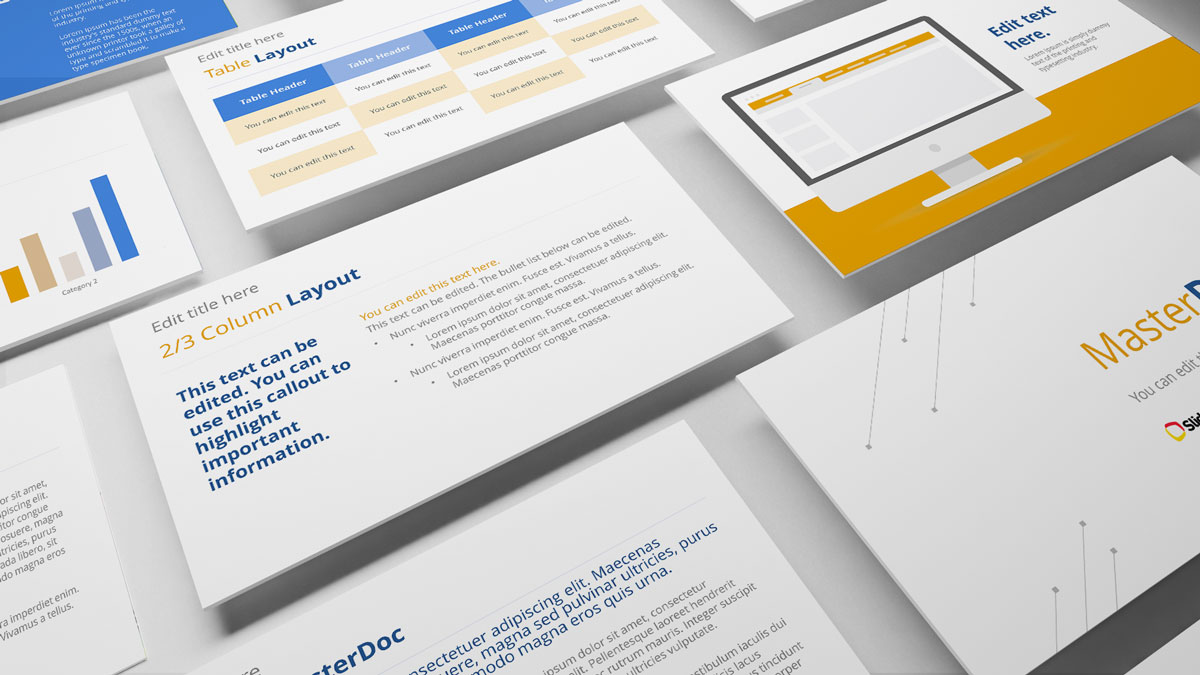
Creating a Thesis presentation should be a straight forward task; based on your thesis document and following the tips described above you have a high level structure already outlined. The MasterDoc PowerPoint template provides professional layouts with texts and image placeholders; so you can create document like slides using your thesis defense as your content. This template is ideal for a highly detailed documents, where visuals and words unite to illustrate one concept per page. The result is an asset that can be read and digested more quickly than either your thesis document or a presentation created for assisting a speech. A document created with the MasterDoc PowerPoint templates is meant to be printed or distributed, read on screen without the accompaniment of a presenter or used in an e-learning platform as pure learning content.
Use This Template
2. Thesis Presentation PowerPoint Template
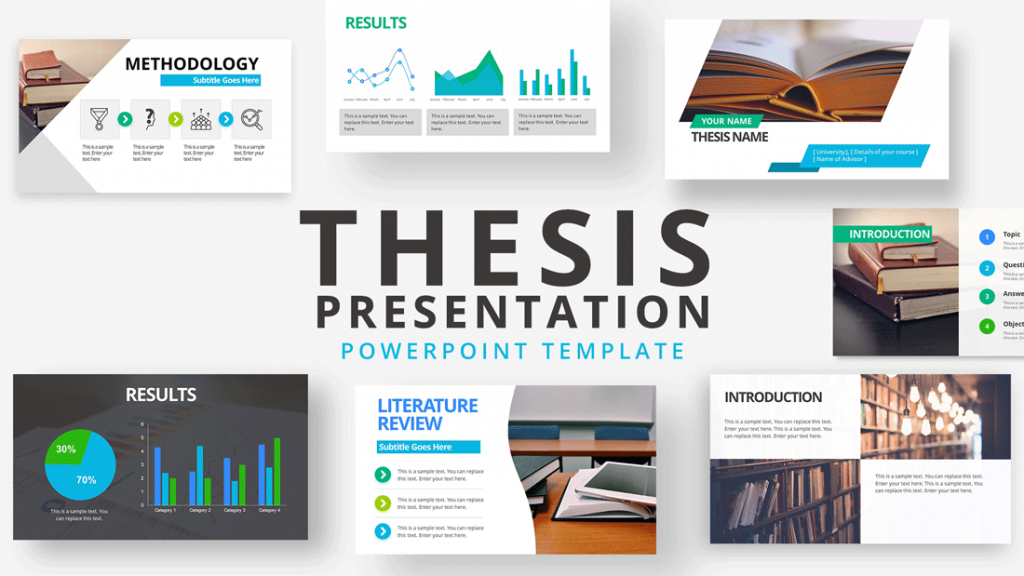
You had invested a considerable time researching, testing hypothesis and confirming your thesis. Craft your thesis presentation with the same level of detail you applied in your work. Using the Thesis Presentation PowerPoint Template you will focus only in your content and your message. The layouts, images,design and structure will be taken care by the template.
3. Master Thesis PowerPoint Template

The Master Thesis PowerPoint Template is a professional document designed for postgraduate degrees presentations. It provides simple sections that follow the structure and best practices of traditional research thesis presentations. Starting with the introduction to the theory and state of the art scenario; following with hypothesis research and its findings and concluding with the confirmation or negation of the initial thesis statement.
4. Essay Outline PowerPoint Template

Your thesis defense can be accompanied by an essay, that states your thesis and argues about it using several supporting paragraphs. This kind of document is ideal to be an intermediate step between reading assisting to the thesis presentation and reading the complete thesis documentation. It has more information that your thesis defense abstract, but does summarizes the supporting evidence and examples that allows the argument of each idea behind the thesis. You can use the Essay Outline Template to present your Essay outline and create an essay linked to your thesis defense documentation.
Like this article? Please share
Academics, Degree, Dissertation, Doctorate, Education, Faculty, Master, PhD, Student, Thesis Filed under Presentation Ideas
Related Articles
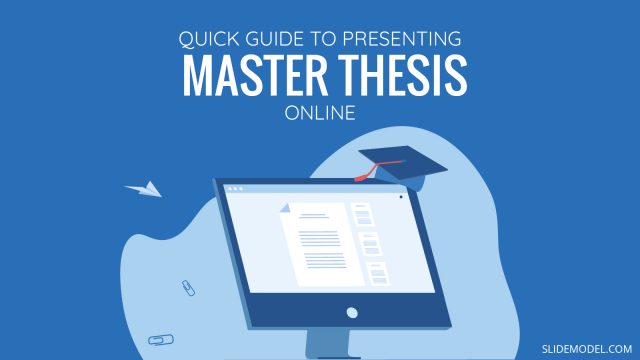
Filed under Education • June 19th, 2024
A Quick Guide to Presenting an Online Master’s Thesis
A Master thesis is one of the most important career times, and can be the make it or break it of years of study. Learn more in this article on how to make it amazing.

Filed under PowerPoint Tutorials • May 22nd, 2024
How to Cite a PowerPoint in APA
Learn how to correctly apply the APA style in your presentations by learning how to cite slides, books and images in APA in PowerPoint.

Filed under Education • April 16th, 2024
How to Write an Essay? Step by Step Guide (Examples Included)
Do you wonder How to write an essay ? Start with the essay structure. This post describes the standard essay structure with its content, and which essay types are popular. Develop your writing skills using the best practices of Essay Structure.
36 Responses to “How To Do a Proper Thesis Defense Using the Right PowerPoint Presentation”
Great job! This has made my thesis presentation a whole lot easier.
Excellent !!!!!
Now I feel I’m quite confident on how to do my dissertation presentation properly and how to defend it. I will share that with other friends and colleagues.
Thank you so much for your kind help.
Best regards, Awad
Thank you for such a valuable guide.
it was very helpful
Thanks a bunch for the general summary for thesis defense with all related information that we might have to know. Great job!
Great tips.
i have proposal defense in two days and im so nervous right now! reading this is helpful in some ways thankyou!
It’s very helpful and understandable. Easy steps to follow.
I found it very helpful to refresh and make my self ready for my defense!
Thank you a lot this article. It’s really helpful!
Naveen Kumar S: Thank you its very Helpful. I appreciate all your effort this is very useful.
Very important and interesting so go on thank you
I really like it. In the near future I am going to present for the MA thesis. Therefore, it will guide me a lot. If you can please attach with this email the detail.
I do like the article as it proves to be valuable and worthy. I enjoyed reading every single note. It helped me feel at ease and have confidence when my viva day takes place. THANK YOU SO MUCH.
Appreciate your Assistance
Thanks a lot for the gist
Thank you so much, I got full information and knowledge.
This has made me look forward to my thesis defense. Thanks a lot
Very useful
thank you very much for your best information
Thank you very much the article is full of knowledge on Thesis as well as dissertation defense. Big Up!
I am appreciative. Well informative and educative.
Thanks immensely for these wonderful tips on presentation during defense. I personally found more useful to me as I prepare to defend my Master Dissertation.
Thank you very much! I now feel more confident.
Thanks for your good self overall usability of the Participations motivated points and contribute significantly in thesis defense practices. Best wishes to one and All
Happy To Help.
Thank you very much. As I am pursuing for my PhD in Leadership, I got it so meaningful and worth having.
Your tips on What a Thesis and Dissertation are, are on point. I have fully understood their differences and similarities. I have also noted the killer way of summaring a Power Point Presentation. Slidemodel.com…you are just a force to reckon with. I need more information…in case you have models you can share with me and those interested in this subject covered.
Thanks a million times for your timely guidance. Just preparing to do my PhD Thesis defense.
this was very, very helpful…Thank you!
Highly appreciate your effort to deliver what a student is looking for. I find your article really helpful and to the point. Thanks !
Regarding to my P.P, I’ve understood so many issues from this. Thankyou!
i got it as it is so important for my deffence presentation, thanky you very much
This Material was very hopeful and encourage any student who prepare any presentation relation with thesis. It also combined more encauragable and it enhance presentation!
Thought provoking content Thank you.
Great comments. very helpful
Leave a Reply
Unsupported browser
This site was designed for modern browsers and tested with Internet Explorer version 10 and later.
It may not look or work correctly on your browser.
- Presentations
How to Start and Give a Great Thesis Defense Presentation
To complete a graduate degree, you'll likely need to create a thesis defense presentation. You must complete a thesis to finish many graduate degree programs.

A thesis is a paper where you explore a topic in depth that's related to what you’ve studied. After completing your thesis paper, you will be asked to defend it through a presentation.
You give this thesis defense in a meeting with a panel of two or more professors in your program. The panel could include other professionals related to your field.
In your thesis defense presentation, you will be asked questions about your topic. The purpose of the questions is to get you to think deeply about your work, so the questions could be open-ended.
To create a thesis defense presentation, you need to know how to make a thesis presentation and how to start your thesis defense. Keep reading to find out more about thesis defense presentations.
How to Structure Your PPT for Thesis Defense

Thesis defense presentations can vary in length. They can be 20 minutes long or two hours long. It depends on how much time is allowed for your presentation and questions.
Talk to your professor to find out how much time is set aside for your presentation. Your thesis defense presentation will be unique to your thesis. But a good presentation includes the following structure:
- Title . You need a title just as your research paper needed a title. The title slide will include the information that you’d include on your paper title. This information can include the title, your name, your school, and course name.
- Introduction . Just like most presentations, your thesis defense presentation should include an introduction slide. This slide should have the topic of your thesis and the question that your presentation answers. It should also include any objections to your research and the answer you’ll be defending in your thesis presentation.
- Literature Review . Next, create two or more slides with a review of the literature used in your research. It doesn’t need to be a complete bibliography. Although you do need to cite your sources, these slides should include your most relevant sources.
- Methodology . These slides in your thesis presentation are where you describe what method you used and an explanation of why you chose that method. If you've got some original research, include the details of that research and how you analyzed the data that you got from that research.
- Results . Some of the most important slides of your PPT for thesis defense contain the results of your research. This should include a description of the data you collected by researching and the results of your data analysis. You also should highlight what your most noteworthy finding was.
- Discussion . These slides of your PPT for thesis defense need to include your research results. Also, show how the results support your argument and how it relates to your original question.
- Conclusion . The conclusion thesis presentation slides should restate your original research questions, show the results of your research, and suggest future research and any final recommendations.
- Ending Slide . The ending slides of your thesis defense presentation are where you add an interesting fact, quote, gif, or hypothetical question. The point is to get your audience to continue to think about your topic while also grabbing their attention. You want your presentation to be memorable.
How to Make a Thesis Presentation
After you’ve seen what the structure of a thesis defense presentation is, there are some more tips that you can follow. Here are tips on how to create a thesis defense presentation:
1. Define Your Concept

After choosing which template to use, the next step is to choose the concept of your thesis defense presentation. Your concept should be relevant to your thesis. To have a fully rounded concept, try to make your presentation templates design relevant to your thesis topic.
Before working on your defense, think about the message you want to convey. This will help you choose elements such as font images and a theme that'll be cohesive.
2. Know Your Audience
Most people give their thesis defense presentation to an academic panel. This panel will look to see if you've developed a thorough understanding of your topic and thesis. They’ll also be looking to see if you've got a solid foundation for your argument.
This is why your presentation is important. You don’t want a sloppy presentation because it can give the impression of laziness and that you don’t care about your presentation. So, choose all aspects of your presentation carefully.
3. Keep Your Slides Focused

Part of giving a good thesis presentation is to have focused slides. This means that you don’t want to have too much information on a slide. It’s best to follow the rule of one point per slide. If you've got too much on a single slide, it can be hard for the audience to follow you.
4. Structure Your Presentation
After you’ve chosen your concept, it's time to structure the content of your thesis. When structuring your information, you want to show that you understand the subject matter and that you're organized.
5. Less Is More

Each slide should have enough information that you can make your point. It’s important that your audience listens more than they read. By speaking, you show your audience that you know the topic you’re presenting on. So, when creating your slides, remember that less is more.
6. Consider Your Typography
After choosing your thesis presentation subject, consider what typography to use. Your typography should create an impact without distracting from your topic.
When considering your typography, consider your text's colors. Your text's colors should contrast with your slide's background. If the text doesn’t contrast well, it can distract the audience, causing them not to pay attention as you speak.
7. Stick to Important Data

Include data that'll strengthen your argument. Your data should also show that you’ve researched your thesis. If you can, add visuals that are relevant to your data. Visuals stimulate your brain and can increase how fast you process information. So, including relevant visuals can make your data easier to process and remember.
8. Consistency Is Key
When thinking about how to make a thesis presentation, think about consistency. For an impressive presentation, your presentation should flow well. It’s easier to have consistency when using a template because it’s already designed by a professional.
Check your finished presentation for consistency. This means making sure all your titles on slides are the same font and font size. Also, make sure that your body text is consistent throughout.
9. Explain Your Thesis

The next step in how to make a thesis presentation is to explain your thesis in great detail. The first part of this is your methodology slide . This is where you explain what method you used for your research, why you chose the topic, and how you conducted your research.
For this part of your thesis, chart and tables in your presentation are helpful in explaining data. In this section, keep your text minimal to let the chart, graphs, and data stand out.
Next, tell the audience what the data means. Infographics are a great option to use in this section. Infographics and icons can quickly and simply show your message.
10. End Your Thesis
The last section of your thesis presentation is where you end it. Make your ending memorable to keep your audience thinking.
In your conclusion, overview your thesis topic and remind the audience of the answer that your research proved. Next, cover the important research points you want your audience to remember. A slide with icons is a great way to do this. Also, address your shortcomings in your research and how there can be improvements in future research.
Finally, use some more presentation tips by reading this helpful article:

A Top Source for Presentation Templates
Envato Elements is the best place for presentation templates. Plus, they also have more than just premium templates. They've icons, photos, fonts, and more. To gain access to these digital elements, you must pay a low monthly fee and sign up to become a member. Once you sign up , you get unlimited access and downloads to digital elements.
Explore Presentation Templates

A premium template saves you time because you're starting with a great base. Just add your information when using a template. This is a lot quicker than trying to design a presentation from scratch. If you like to customize your presentation, you still can find a good premium template that's easily customizable.
Every template is designed by a professional to look stylish and impressive. This means that your presentation will stand out among all the made-from-scratch presentations.
Use a Premium Template for Your Thesis Defense Presentation Today!
Now that you’ve been given tips on how to start a thesis presentation and what it should contain, put this information to use when creating your thesis presentation. Save time from having to create a presentation from scratch by downloading a premium template today!

- Columbus’s Katalina’s Eatery Channel’s Modern Twist on Classic Foods
- Through the Eyes of an Educator: The In-Between

Search form
How to make a good thesis presentation.

A strong thesis defense is crucial for any doctorate or graduate student. Although researching and writing about your thesis topic can be a Herculean effort, the work doesn't end there. The thesis presentation is a crucial part of the dissertation defense in many academic programs.

Your impressive presentation will show the depth of research in your thesis clearly and compellingly. Your presentation gives your committee an excellent visual to validate the thesis. Impress your jury with impactful PowerPoint presentations.
What is a thesis presentation?
A thesis is an accumulation of all your research on paper. A thesis presentation can be a digital summary of your research, focusing on the core knowledge in your thesis. It's short and concise. Each slide should have a purpose, as this presentation provides a detailed insight into your thesis research and conclusions.
https://thesisgeek.com/ allows you to display the narrative progression of your thesis. The process begins by asking questions, researching the topic, creating the study, and evaluating it. By using this, you will be able to create the wow-worthy presentation.
You must pass your thesis presentation to be awarded your degree.
The Structure of Your Thesis Presentation
You can use this structure to help you align your slides to help you maintain consistency in your narrative by guiding the flow of design.
* Problem Statement * Literature Review * The Purpose of the Study * Research Questions * Instruments * Data collection * Research findings * Implications * Recommendations * You can also read about it here * Acknowledgements * Questions
Are you unsure of how to create a memorable and perfect thesis presentation? SlideModel provides unique thesis presentation templates that will impress your committee.
8 Tips for a stunning thesis presentation

1. Decluttered Slides
When the thesis presentation is structured smoothly, it will have the greatest impact. Overloaded slides will confuse both you and the panel. Each slide should be focused on a single topic, and contain minimal information.
Create a title slide that will grab the audience's attention. Keep your thesis presentation simple and concise to echo your topic.
2. Compelling Templates
Remember that the committee reviewing your thesis presentation is likely to have seen countless slideshows throughout their life. How can you impress them with something different?
Using eye-catching, customized templates adds a new dimension to the information you have collected. The fact that the templates are 100% editable allows you to save time and create a beautiful presentation in minutes. Templates also have a carefully chosen and attractive color scheme that will make your job easier.
3. Design Consistency
Each slide of your thesis presentation should be visually synchronized. Consistency in design creates a pleasing aesthetic. This consistency also makes your presentation look logical and smooth. Your committee might be distracted by sudden changes in style and lose the thread of your argument.
Choose a color scheme that corresponds to your topic, and then incorporate it into a thesis template. Stick to the color scheme and avoid changing themes drastically. Remember the primary and secondary colors of your slides. Dark-colored text should be placed on a lighter background, and light-colored text on a darker one. Keep in mind accessibility issues when choosing colors and backgrounds.
4. Engaging Visuals
Humans tend to remember more when presented with visually appealing information. Include multimedia that is relevant to your topic in your thesis defense presentation. This allows your audience to quickly glance at information.
Use HD images, audio clips, and videos to enhance your thesis presentation. Focusing on visual hierarchy is a tip you should keep in mind. You should place your content on your slides in the order you would like your audience to view it. This can be achieved by either highlighting text or increasing the slide content proportionally.
5. Data Visualizations
Data visualizations are the best way to present your research and analysis. Textual numbers and conclusions are not recommended. These slides are from a past era. Visualizations are always a great way to spice up your slide topics, whether it's about blended models or data on hybrid learning.
You can create top-notch data visualisations using a variety of templates, including charts, graphs, and trend lines. The combination of comprehensive analysis and data visualizations has a double effect of uniqueness and information digestability.
6. Attractive Infographics
Infographics can be used to draw your audience in and help you defend your thesis. Instantly, they make your information look more lively and attractive. You can create vibrant infographics using a variety of presentation templates (see above).
Use infographics to show the uniqueness of your thesis topic. You can also use it to show comparisons or improvements made in previous research on your thesis topic. These infographics are able to visualize nearly every topic, from research analysis and implications.
7. Typography
You will not get very far if you fill your slides with text. It is better to write one-liners and points instead of long paragraphs. We can assure you that your committee will not be interested in large paragraphs. Your visuals and verbal content will be the focus of their attention.
Save the rest of the information for your speech. Choose functional fonts for your slides to make the text legible. Fancy fonts can give your slides a amateur appearance and confuse your audience.
8. Include Storytelling
When presented as a story, any information or thesis becomes more engaging than a simple speech. Create a story that will help you move your presentation forward. Your audience will be captivated and want more.
Storytelling, when skillfully integrated into a thesis defense, offers several benefits. Firstly, it humanizes the research. Behind every dataset and analysis lies a researcher who embarked on a quest to unravel mysteries and contribute to knowledge. By sharing the personal journey and struggles encountered during the research, a narrative is created that resonates with the audience on a human level. This connection fosters empathy, making the defense not just a presentation of facts, but a shared experience.
Moreover, storytelling facilitates comprehension. Complex theories and intricate methodologies can be difficult for non-experts to grasp. Through storytelling, these concepts can be simplified and contextualized, making them accessible to a wider audience. Analogies, anecdotes, and relatable examples become tools to bridge the gap between specialized knowledge and general understanding.

The story you tell in your thesis presentation slide must be engaging and captivating from the beginning. Bestselling author Robin Sharma believes that starting strong can be beneficial. Finishing strong is more impressive.
To achieve this, you should design your title slide and final slides in a striking way. Practice before the final and practice the narration. Create a stunning slideshow to defend your thesis. Use the tips above...you'll be glad you did!
- Log in to post comments
Popular Tags
Wandering Educators
Music for Shifting Times

Through the Eyes of an Educator: A Compendium

Exploring Michigan's Coasts: A Compendium

Generation Study Abroad Commitment Partner

I'm a White House Travel Blogger

Wandering Educators Youth Travel Blogging Mentorship Program

Travel with Awe and Wonder: A Compendium

- Accommodations
- Books & Film
- Global Citizenship
- Intercultural Education
- Marketplace
- Opportunities
- Performing Arts
- Southeast Asia
- Special Interest
- Transportation
- Travel Planning
- Travel Tips
Recent posts
Learn spanish in spain: imme..., saugatuck’s oval beach, top study abroad destination..., read this: the sea hides a s..., from good to great: techniqu....
- Request new password

These cookies are required for the website to run and cannot be switched off. Such cookies are only set in response to actions made by you such as language, currency, login session, privacy preferences. You can set your browser to block these cookies but this might affect the way our site is working.
These cookies are usually set by our marketing and advertising partners. They may be used by them to build a profile of your interest and later show you relevant ads. If you do not allow these cookies you will not experience targeted ads for your interests.
These cookies enable our website to offer additional functions and personal settings. They can be set by us or by third-party service providers that we have placed on our pages. If you do not allow these cookies, these services may not work properly.
These cookies allow us to measure visitors traffic and see traffic sources by collecting information in data sets. They also help us understand which products and actions are more popular than others.
How to Pull Off Your Thesis Defense With a Great Presentation

You’ve reached the home stretch in your journey toward your post-graduate degree. You’ve diligently studied, researched and performed for years, and all that’s left is your master thesis or doctorate dissertation.
“ All that’s left,” however, might be the understatement of the century. There’s nothing simple about orally defending your thesis, and this final stage often means the difference between a degree and a program that remains incomplete.
Even after you’ve dedicated months filled with blood, sweat and tears defining your argument, researching your support and writing your defense, you aren’t ready to address the academic panel. You still have to design an effective visual presentation, and the slide deck can make or break your entire thesis.
Unsure how to design a stellar slide deck to visually present your thesis or dissertation? Check out the following tips to pull off your master thesis defense with a great presentation:
1. Properly structure your slide deck
Every master thesis defense presentation is unique, but most effective slide decks will follow a similar structure, including:
- Title - Just like a research paper, your thesis presentation must include a title slide. This should include the same information as any other title page: the title, your name, your academic institution, course name and the name of the academic advisor to your thesis or dissertation. That doesn’t mean your title slide needs to look like the start of any other Frankendeck . Instead, add your text atop a relative image, and adjust the brightness to ensure your text pops.
- Introduction - Your thesis presentation should also include an introduction slide, which details the topic of your thesis, the question your research will seek to answer and any additional objectives to your research, as well as the answer or solution you will be defending.
- Literature review - Following your thesis introduction, design one or more slides that review the literature you researched. This shouldn’t be a full bibliography (although that should be included in the accompanying written account of your research), but instead, the slides should list your most relevant research sources. If the information is featured on a slide, make sure you include its source.
- Methodology - Your thesis presentation slide deck should also include a slide (or slides) detailing the methodology of your research and argument. Here you want to describe the type of study— whether it’s quantitative, qualitative or a combination of the two, as well as an explanation of why you chose the method or methods you used. If you conducted original research, you will want to detail the study population, sampling methods and other details pertinent to your studies, while you’ll also want to detail how you analyzed your data.
- Results - No thesis presentation slide deck is complete without dedicating slides to illustrate the results of your research. Be sure to include a description of any data you collected through your research, as well as the results of your analysis of the data. What were your most significant findings?
- Discussion - How do the results of your research support your overall thesis argument? Be sure to include slides that discuss your overall findings and how they relate to your original question.
- Conclusion - Concluding slides should restate your original research questions, represent the results of your research, suggest future research and make any final recommendations.
- Ending slide – Close your thesis presentation with a concluding slide that offers an interesting quote or trivia that makes your audience further ponder your topic, a GIF or animation that recaptures the audience’s attention or even a hypothetical question that opens additional discussion from the academic panel. This is your opportunity to make your presentation memorable.

Thesis Presentation vs. Dissertation
Thesis presentation and dissertation are two terms often used in academic settings related to upper education. While they are related, there are distinct differences between the two, which is important to understand as you begin to structure your thesis defense.
A thesis presentation typically refers to the final oral presentation that a student gives to defend their thesis or research project. It is a formal presentation to explain their findings, methodology, and conclusions to a panel of faculty members or experts in the field. The purpose of a thesis defense presentation is to demonstrate the student's knowledge and understanding of the subject matter and to defend the validity of their research.
On the other hand, a dissertation refers to a lengthy and comprehensive research project that is typically required for the completion of a doctoral degree. It involves in-depth research, analysis, and the development of original ideas in a particular field of study. A dissertation is usually written over an extended period and is expected to contribute new knowledge or insights to the field. Unlike a thesis presentation, a dissertation is submitted in written form and is typically evaluated by a committee of faculty members or experts in the field.
2. Choose which ideas to illustrate
Unless you have an hour to fill with your master thesis defense or doctorate dissertation, you won’t be able to include every idea from your overall research documentation in your slide show. Choose the most important ideas to illustrate on slides, while also keeping in mind what aspects of your research you’ll be able to visually represent.
.webp)
3. Define your presentation’s theme
A stellar thesis or dissertation presentation will be professional in appearance, and a cohesive design is an absolute must. Choose what types of typography and color schemes best support your topic.
Instead of adjusting these settings on each individual slide— a tedious task at best— choose a PowerPoint-alternative presentation software like Beautiful.ai that allows you to customize a theme for your entire slide deck. Choose your fonts and other typography, your color palette, margins, footers, logos, transitions and more, and the cloud-based tool will automatically apply those design specifications to every slide you add to the master thesis defense presentation.
4. Design simple and focused slides
You might have a lot of information to present, but when it comes to your thesis presentation— or almost any slide deck for that matter— less is more. Be sure every slide counts by focusing on your main points.
Then, whatever you do, keep your slides simple. Not even an academic panel is going to dedicate much time deciphering a cluttered slide with all too many details. Try to avoid presenting more than one or two ideas on each slide.
5. Include data visualizations
The whole point of your presentation is to illustrate the concepts included in your thesis. Humans are visual creatures and react strongly to imagery, and the panel evaluating your thesis or dissertation is no exception— regardless of how studious and formal the academics might seem. Illustrate the results of your research with colorful and engaging infographics . You don’t have to be a graphic designer to create them, either.
Beautiful.ai users can choose from a host of smart slide templates with data visualizations — including favorites like bar graphs and pie charts , as well as less common options like scattergraphs , flow charts and pictograms . Just input your data and watch as our special brand of artificial intelligence creates the infographic for you.
6. Practice makes perfect
After spending months researching your thesis or dissertation, writing about your findings and designing a stellar master thesis defense presentation, you would hate to see all your hard work be for naught. That’s still a distinct possibility, however, if you don’t also practice your delivery.
Practice, practice and practice some more until you know your master thesis defense like the back of your hand. No academic panel will be impressed by a graduate candidate who stumbles through their presentation or appears to be reading from their notes. Know the contents of every slide, as well as exactly what parts of your overall defense you want to deliver during its display.
Things to keep in mind to help you nail your presentation
The golden rule of any presentation is to keep your audience engaged. You can ensure a more engaging presentation by maintaining eye contact, using appropriate gestures, and speaking clearly. You can also choose to include the audience in your presentation with interactive questions, polls, and slides.
To help boost audience retention, utilize storytelling. Studies show that when facts are presented in the form of a story, people are 22 times more likely to remember them. Talk about powerful.
Last but not least, plan for questions— and not simply by allowing time for them. Watch other thesis defenses delivered at your institution, and consider what types of questions the academic panel might ask, so you can prepare the best possible answer.
Extra credit:
Get started with our PhD Defense Thesis presentation template here .

Samantha Pratt Lile
Samantha is an independent journalist, editor, blogger and content manager. Examples of her published work can be found at sites including the Huffington Post, Thrive Global, and Buzzfeed.
Recommended Articles
Beautiful.ai is your presentation shortcut, how to write an effective story for your presentation, how to get the most out of a sales call using presentations, medical presentations: how to present effectively on urgent topics.

PhD Dissertation Defense Slides Design: Start
- Tips for designing the slides
- Presentation checklist
- Example slides
- Additional Resources
Purpose of the Guide
This guide was created to help ph.d. students in engineering fields to design dissertation defense presentations. the guide provides 1) tips on how to effectively communicate research, and 2) full presentation examples from ph.d. graduates. the tips on designing effective slides are not restricted to dissertation defense presentations; they can be used in designing other types of presentations such as conference talks, qualification and proposal exams, and technical seminars., the tips and examples are used to help students to design effective presentation. the technical contents in all examples are subject to copyright, please do not replicate. , if you need help in designing your presentation, please contact julie chen ([email protected]) for individual consultation. .
- Example Slides Repository
- Defense slides examples Link to examples dissertation defense slides.
Useful Links
- CIT Thesis and dissertation standards
- Dissertations and Theses @ Carnegie Mellon This link opens in a new window Covers 1920-present. Full text of some dissertations may be available 1997-present. Citations and abstracts of dissertations and theses CMU graduate students have published through UMI Dissertation Publishing. In addition to citations and abstracts, the service provides free access to 24 page previews and the full text in PDF format, when available. In most cases, this will be works published in 1997 forward.
- Communicate your research data Data visualization is very important in communicating your data effectively. Check out these do's and don'ts for designing figures.
Power Point Template and other Resources
- CEE Powerpoint Slide Presentation Template 1
- CEE Powerpoint Slide Presentation Template 2
Source: CEE Department Resources https://www.cmu.edu/cee/resources/index.html
- CMU Powerpoint Slide Template
Source: CMU Marketing and Communications
https://www.cmu.edu/marcom/brand-standards/downloads/index.html
- Use of CMU logos, marks, and Unitmarks
Email me for questions and schedule an appointment

Top 7 tips for your defense presentation
1. show why your study is important, remember, your audience is your committee members, researchers in other fields, and even the general public. you want to convince all of them why you deserve a ph.d. degree. you need to talk about why your study is important to the world. in the engineering field, you also need to talk about how your study is useful. try to discuss why current practice is problematic or not good enough, what needs to be solved, and what the potential benefits will be. , see how dr. posen and dr. malings explained the importance of their studies..
- Carl Malings Defense Slides with Notes
- I. Daniel Posen Defense Slides with Notes
2. Emphasize YOUR contribution
Having a ph.d. means that you have made some novel contributions to the grand field. this is about you and your research. you need to keep emphasizing your contributions throughout your presentation. after talking about what needs to be solved, try to focus on emphasizing the novelty of your work. what problems can be solved using your research outcomes what breakthroughs have you made to the field why are your methods and outcomes outstanding you need to incorporate answers to these questions in your presentation. , be clear what your contributions are in the introduction section; separate what was done by others and what was done by you. , 3. connect your projects into a whole piece of work, you might have been doing multiple projects that are not strongly connected. to figure out how to connect them into a whole piece, use visualizations such as flow charts to convince your audience. the two slides below are two examples. in the first slide, which was presented in the introduction section, the presenter used a flow diagram to show the connection between the three projects. in the second slide, the presenter used key figures and a unique color for each project to show the connection..

- Xiaoju Chen Defense Slides with Notes
4. Tell a good story
The committee members do not necessarily have the same background knowledge as you. plus, there could be researchers from other fields and even the general public in the room. you want to make sure all of your audience can understand as much as possible. focus on the big picture rather than technical details; make sure you use simple language to explain your methods and results. your committee has read your dissertation before your defense, but others have not. , dr. cook and dr. velibeyoglu did a good job explaining their research to everyone. the introduction sessions in their presentations are well designed for this purpose. .
- Laren M. Cook Defense Slides with Notes
- Irem Velibeyoglu Defense with Notes
5. Transition, transition, transition
Use transition slides to connect projects , it's a long presentation with different research projects. you want to use some sort of transition to remind your audience what you have been talking about and what is next. you may use a slide that is designed for this purpose throughout your presentation. , below are two examples. these slides were presented after the introduction section. the presenters used the same slides and highlighted the items for project one to indicate that they were moving on to the first project. throughout the presentation, they used these slides and highlighted different sections to indicate how these projects fit into the whole dissertation. .

You can also use some other indications on your slides, but remember not to make your slides too busy. Below are two examples. In the first example, the presenter used chapter numbers to indicate what he was talking about. In the second example, the presenter used a progress bar with keywords for each chapter as the indicator.

Use transition sentences to connect slides
Remember transition sentences are also important; use them to summarize what you have said and tell your audience what they will expect next. if you keep forgetting the transition sentence, write a note on your presentation. you can either write down a full sentence of what you want to say or some keywords., 6. be brief, put details in backup slides , you won't have time to explain all of the details. if your defense presentation is scheduled for 45 minutes, you can only spend around 10 minutes for each project - that's shorter than a normal research conference presentation focus on the big picture and leave details behind. you can put the details in your backup slides, so you might find them useful when your committee (and other members of the audience) ask questions regarding these details., 7. show your presentation to your advisor and colleagues, make sure to ask your advisor(s) for their comments. they might have a different view on what should be emphasized and what should be elaborated. , you also want to practice at least once in front of your colleagues. they can be your lab mates, people who work in your research group, and/or your friends. they do not have to be experts in your field. ask them to give you some feedback - their comments can be extremely helpful to improve your presentation. , below are some other tips and resources to design your defense presentation. .
- Tips for designing your defense presentation
How important is your presentation, and cookies?

- Next: Tips for designing the slides >>
- Last Updated: Jan 9, 2024 11:18 AM
- URL: https://guides.library.cmu.edu/c.php?g=883178
8 Tips to Ace Your Thesis Defense Presentation
- By Judhajit Sen
- June 7, 2024
If you’re a graduate student nearing the end of your degree, you’re likely familiar with the term “thesis defense.” In many countries, completing a graduate degree involves writing a thesis—a substantial paper based on your field of study topic.
After submitting the formal presentation on your thesis, you’ll be given a date for your defense. This meeting usually includes you and a committee of two or more professors from your program and sometimes other professionals from related fields. During the defense, you’ll answer questions about your work to demonstrate your understanding of your field and focus area.
A thesis defense has two main parts: the thesis and the defense. The thesis shows your understanding of your program and major, and it’s more than just an extended essay. It asserts something significant about your research topic and is one of the most crucial documents you’ll produce during your academic career.
The defense is where you present evidence to support and prove your research. You must be prepared to answer questions from the committee and any other panel members. It’s your job to convince them of your thesis’s validity with ample proof. Before your academic literature review, carefully determine the evidence you’ll present to support your thesis best.
While the thesis defense might seem daunting, it’s often more of a formality to ensure you understand your work thoroughly rather than an intense interrogation.
The following are eight tips for acing your thesis defense presentation.
Key Takeaways
- Focus on Main Ideas: Prioritize the most critical points and keep your presentation templates simple with minimal text to ensure clarity and engagement.
- Emphasize Core Concept: Highlight your thesis’s main idea and unique contributions. Use appropriate design elements and visuals to support your message and make it understandable for a diverse audience.
- Smooth Transitions and Practice: Ensure logical flow between the templates and practice your presentation thoroughly. This preparation helps maintain audience engagement and boosts your confidence during the defense.
- Anticipate Questions and Stay Calm: Prepare for potential questions from the committee. It’s OK not to know every answer; handle unknown questions thoughtfully. Manage nerves through deep breathing, rest, and planning a post-defense celebration.
Choose Which Ideas to Present
When preparing your effective presentation outline , it’s important to remember that you won’t have time to cover everything. Focus on the most critical ideas that best illustrate your research. Prioritize the main points and key findings you can visually represent in your ppt.
Your presentation time is limited. For a 45-minute defense, you’ll have about 10 minutes per project, shorter than a typical research conference presentation. Concentrate on the big picture and leave the finer details for the Q&A session. Keep backup slides with additional information ready, as these might come in handy if the committee asks specific questions.
Remember, your audience has seen many good presentations packed with data and details. Avoid overwhelming them with too much information. Instead, simplify your deck by focusing on one point per slide. This approach helps the committee follow your argument more easily and makes your defense more effective.
Use minimal text on your slides. The committee wants to hear you speak passionately and authentically about your research, not read blocks of text. Each slide should act as a cue for your discussion. Ensure there’s enough white space to keep the audience’s attention on the critical elements of each slide.
You don’t need to include everything from your paper in your presentation script . Narrow down your ideas to the most critical details, such as your statistics and findings. If the committee wants more information, they’ll ask during the defense.
Explore the Main Idea of Your Thesis Presentation
When preparing for your thesis defense, remember that your audience includes your committee members, researchers from other fields, and the general public. Your goal is to show everyone why your study is essential and how it makes a difference. For example, if you’re in engineering, explain how your work can be applied practically. Highlight the problems with current practices, what needs to be fixed, and the benefits your research offers.
Your thesis has a main idea, which should be clear in your presentation title page. Everything, from the design to the text, should reflect this core concept. A well-designed persuasive presentation helps engage your audience and shows your deep understanding of your research area. Before you start designing your slides, define your main idea. Use fonts, images, and best colors for ppt presentation that support your message. For example, avoid playful designs if your research is about vulnerable communities. Instead, use bold and clear fonts to emphasize important points.
Every image and visual element should support the accompanying text. Ensure your slides look professional, are free from clutter, and are easy to understand. If your answer to whether each slide meets these criteria is yes, you’re on the right path.
Choose a Google Slides or PowerPoint template that fits your thesis topic. Your design should reflect your central theme, guiding your color, font, and image choices. These design elements must align with your thesis’s message visually and contextually.
In your thesis PowerPoint presentation, continually emphasize your unique contributions. Clearly distinguish your work from that of others. Explain what problems your research solves and the breakthroughs you’ve made. Highlight why your methodology and outcomes are exceptional.
Remember, not everyone in your audience has your background knowledge. Focus on the big picture and use simple language to explain your methods and results. Your committee has read your dissertation, but others may not have. Ensure your presentation is understandable to all, keeping technical details to a minimum. This approach will help everyone understand your work’s significance and why you deserve your Ph.D.
Your Slide Transition Must be Smooth and Logical
Smooth and logical transitions between slides are crucial in your thesis defense. You are presenting a long and detailed research project, so it’s important to remind your audience of what you have discussed and what comes next. Use slides specifically designed for transitions throughout your presentation. This helps keep the flow consistent and is an excellent audience engagement strategy .
Avoid making your slides too busy with excessive indicators or information. Simple and clear transition sentences are vital. These sentences should summarize the main points you’ve covered and introduce the upcoming topic. If you tend to forget these transitions, write a note on your presentation slides. This note can be a complete sentence or keywords to jog your memory.
Ensure that each slide logically follows the previous one. Consistency is vital, not just in content but also in design. Stick to one color scheme and layout template throughout your presentation. Avoid sudden style changes, as they can distract your committee and make it harder for them to follow your argument. A smooth, logical progression in both your content and design is an effective presentation technique that will help keep your audience on track and engaged from start to finish.
Practice Your Presentation
After spending months on your thesis, writing up your findings, and creating an excellent presentation, you don’t want all that hard work to go to waste. This could happen if you don’t practice your delivery. Practice until you know your thesis defense inside and out. No academic panel will be impressed if you stumble through your presentation or read straight from your notes. Know every slide and what you want to say with each one.
Even if you feel confident, review your materials. You can carry a hard copy of your thesis, but don’t rely on it during your presentation. Know your paper thoroughly to avoid getting lost.
It’s OK if your oral defense sounds scripted. This is expected. Practicing is crucial, especially if there’s a time limit. Make sure your slides fit within the allotted time. For instance, a 15 to 20-minute presentation shouldn’t have a hundred slides, and a one-hour defense shouldn’t have just ten slides. Practice in front of an audience for a more effective rehearsal.
Remember, you might experience complete silence in the defense room. You could feel awkward because you’re the only one speaking most of the time. Practicing this scenario is normal and can help you feel more comfortable.
Incorporate Data Visualizations, but Don’t Go Overboard
When presenting your thesis, the main goal is clearly explaining your research’s ideas. People respond well to visuals, including the panel evaluating your work. Using colorful and engaging infographics can make your results stand out.
Adding facts and figures to your presentation is essential because it shows you’ve done thorough research. However, you must be careful about how much data you put on each slide. Your audience must understand what’s on the screen while listening to your public speaking . If your data presentation is too packed with information, it can be overwhelming and distracting, causing them to miss your key points.
Only include data that adds value to your argument to keep your audience focused. Use visuals like original or stock graphics to present this information. Research indicates that visuals can boost the brain’s learning ability by up to 400% , making it easier and faster for people to process information. By incorporating dynamic pictures that explain your data, you help the committee understand and absorb your findings more effectively.
Be Prepared to Answer Questions
When you’re gearing up for your thesis defense, being ready to tackle questions is critical. Here’s what you need to know:
Anticipate Questions: You can get ready for most of the questions coming your way. Take a good look at your thesis and jot down possible questions while you read. Also, check out who’s on your committee and what they specialize in. What topics are they likely to focus on? Sitting in on other defenses with these committee members can give you a heads-up on their questioning style.
Know Your Committee: The panel is there to challenge you, often with tough questions. They want to see if you know your stuff and are well-prepared. But don’t sweat it! You’re on the right track if you’re confident about your research.
Stay Confident: No matter what questions they throw at you, keep your cool. Make sure what you say during your defense matches what’s in your thesis. As long as you’re solid on your paper’s details, you’ve got this!

When You Don’t Know the Answer!
One scary scenario in a thesis defense is the chance of getting a question you can’t answer. You can prepare for many questions, but you can’t predict everything that will be asked. Remember, your thesis defense isn’t about being perfect or knowing everything. It’s about how you handle challenging situations.
Examiners sometimes ask questions they themselves don’t know the answer to. They might do this out of curiosity or to see how you think. It’s OK to say, “I don’t know,” but try to add something like, “I don’t know, but I would think […] because of x and y. To find out, you would need to do […].” This shows you can think like an academic.
Don’t make up something without proof or context if you don’t know the answer. Giving a baseless answer can hurt your credibility in a speech . Instead, be honest and thoughtful. This approach shows your integrity and ability to think critically under pressure.
It’s OK to Be Nervous
It’s completely normal to feel nervous during your thesis defense. Your examiners know this and will expect it. They have seen many presenters in your position and are usually willing to help, such as by repeating questions if needed. Remember, it’s a myth that thesis committees are out to get you.
When you’re nervous, you might talk fast or laugh without reason. Here are some tips to help you manage your stress:
Meditational breathing: Try some calming breaths right before your defense. Exercise and sleep: Get plenty of both in the weeks leading up to your defense. Preparation: Have everything you need ready the night before. Processing questions: Allow yourself to think about each question before you answer. Post-defense plans: Plan a fun activity with friends or family, like dinner or mini-golf, to look forward to after your defense.
Remember, it’s OK to take your time during the defense. Pausing to gather your thoughts is better than rushing through your answers. This will help the committee clearly understand what you are trying to say.
Your defense won’t be perfect, and that’s OK. Mistakes happen. Careful preparation can help you feel less stressed. Planning something enjoyable afterward can also give you something positive to look forward to.
Shine in Your Thesis Defense Presentation
Mastering your thesis defense is a crucial step in your academic journey, and preparation is critical. Focus on presenting your main ideas clearly and concisely. Prioritize significant points and findings, and use simple slides with minimal text to engage your audience effectively. Ensure your core concept is highlighted, and your unique contributions stand out.
Smooth transitions between slides maintain the flow of your presentation. Practice your delivery extensively to ensure you know your material inside and out. Incorporate data visualization in your presentation wisely to support your arguments without overwhelming your audience.
Anticipate potential questions from your committee and prepare thoughtful responses. If you encounter a question you can’t answer, admitting it while offering a logical next step is OK. Remember, defense is not about perfection but about demonstrating your understanding and ability to handle challenging situations.
Nerves are normal, but manage them through deep breathing, adequate rest, and exercise. Preparation and mindfulness can reduce stress, helping you perform confidently. Plan a rewarding activity after your defense to celebrate your hard work. With these strategies, you can confidently ace your thesis defense.
Frequently Asked Questions (FAQs)
1. What is thesis defense? A thesis defense is a formal meeting where you present your research to a committee of professors. You’ll answer their questions to demonstrate your understanding of your work and field.
2. How should I prepare my presentation slides? Focus on the main ideas and critical findings. Support your points with minimal text and clear visuals. Ensure your slides are professional and easy to understand, avoiding clutter and excessive details.
3. What should I do if I don’t know the answer to a question? It’s OK to admit if you don’t know an answer. Try to think through the question and suggest a logical next step. This shows your ability to think critically and handle challenging situations.
4. How can I manage my nerves during my defense? Feeling nervous is normal. Practice deep breathing, get plenty of rest, and exercise regularly. Being well-prepared can boost your confidence. Remember to take your time when answering questions.
Master Thesis Defense Presentation with Prezentium
Transform your thesis presentation from daunting to dazzling with Prezentium ‘s AI-powered services. Preparing a compelling and visually stunning thesis defense is crucial for showcasing your research and impressing your committee. Prezentium specializes in creating top-tier presentations that combine visual design and data science, ensuring your hard work is presented flawlessly.
Our Overnight Presentation service guarantees a polished and professional presentation delivered to your inbox within one working day. Simply send us your requirements by 5:30 pm PST, and wake up the following day to a presentation that effectively communicates your main ideas, core concepts, and critical findings with clear and engaging slides by 9:30 am PST.
For a more tailored approach, our Presentation Specialist s can transform your notes and ideas into a refined and captivating presentation. They’ll work with you to create custom designs and templates that reflect the essence of your research, making your thesis defense informative and visually compelling.
Enhance your presentation skills with Zenith Learning , which offers interactive workshops and training programs. These sessions will help you master structured problem-solving and visual storytelling, essential for delivering a confident and persuasive thesis defense.
Don’t let the stress of creating a presentation overshadow your academic achievements. Contact Prezentium today and let us help you make a lasting impression with the best thesis defense presentation ppt.
Why wait? Avail a complimentary 1-on-1 session with our presentation expert. See how other enterprise leaders are creating impactful presentations with us.
Remote Team Tips: 5 Ways to Improve Remote Communication
Prepare for a presentation: 11 presentation preparation tips, communication methods: 5 ways to communicate at the workplace.
Reference management. Clean and simple.
How to prepare an excellent thesis defense
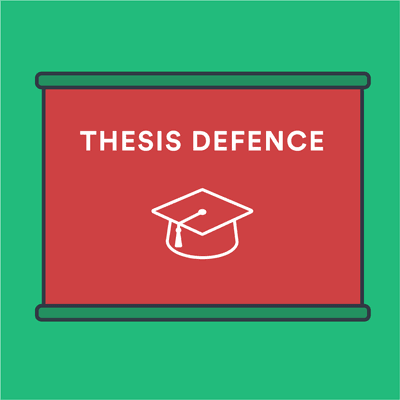
What is a thesis defense?
How long is a thesis defense, what happens at a thesis defense, your presentation, questions from the committee, 6 tips to help you prepare for your thesis defense, 1. anticipate questions and prepare for them, 2. dress for success, 3. ask for help, as needed, 4. have a backup plan, 5. prepare for the possibility that you might not know an answer, 6. de-stress before, during, and after, frequently asked questions about preparing an excellent thesis defense, related articles.
If you're about to complete, or have ever completed a graduate degree, you have most likely come across the term "thesis defense." In many countries, to finish a graduate degree, you have to write a thesis .
A thesis is a large paper, or multi-chapter work, based on a topic relating to your field of study.
Once you hand in your thesis, you will be assigned a date to defend your work. Your thesis defense meeting usually consists of you and a committee of two or more professors working in your program. It may also include other people, like professionals from other colleges or those who are working in your field.
During your thesis defense, you will be asked questions about your work. The main purpose of your thesis defense is for the committee to make sure that you actually understand your field and focus area.
The questions are usually open-ended and require the student to think critically about their work. By the time of your thesis defense, your paper has already been evaluated. The questions asked are not designed so that you actually have to aggressively "defend" your work; often, your thesis defense is more of a formality required so that you can get your degree.
- Check with your department about requirements and timing.
- Re-read your thesis.
- Anticipate questions and prepare for them.
- Create a back-up plan to deal with technology hiccups.
- Plan de-stressing activities both before, and after, your defense.
How long your oral thesis defense is depends largely on the institution and requirements of your degree. It is best to consult your department or institution about this. In general, a thesis defense may take only 20 minutes, but it may also take two hours or more. The length also depends on how much time is allocated to the presentation and questioning part.
Tip: Check with your department or institution as soon as possible to determine the approved length for a thesis defense.
First of all, be aware that a thesis defense varies from country to country. This is just a general overview, but a thesis defense can take many different formats. Some are closed, others are public defenses. Some take place with two committee members, some with more examiners.
The same goes for the length of your thesis defense, as mentioned above. The most important first step for you is to clarify with your department what the structure of your thesis defense will look like. In general, your thesis defense will include:
- your presentation of around 20-30 minutes
- questions from the committee
- questions from the audience (if the defense is public and the department allows it)
You might have to give a presentation, often with Powerpoint, Google slides, or Keynote slides. Make sure to prepare an appropriate amount of slides. A general rule is to use about 10 slides for a 20-minute presentation.
But that also depends on your specific topic and the way you present. The good news is that there will be plenty of time ahead of your thesis defense to prepare your slides and practice your presentation alone and in front of friends or family.
Tip: Practice delivering your thesis presentation in front of family, friends, or colleagues.
You can prepare your slides by using information from your thesis' first chapter (the overview of your thesis) as a framework or outline. Substantive information in your thesis should correspond with your slides.
Make sure your slides are of good quality— both in terms of the integrity of the information and the appearance. If you need more help with how to prepare your presentation slides, both the ASQ Higher Education Brief and James Hayton have good guidelines on the topic.
The committee will ask questions about your work after you finish your presentation. The questions will most likely be about the core content of your thesis, such as what you learned from the study you conducted. They may also ask you to summarize certain findings and to discuss how your work will contribute to the existing body of knowledge.
Tip: Read your entire thesis in preparation of the questions, so you have a refreshed perspective on your work.
While you are preparing, you can create a list of possible questions and try to answer them. You can foresee many of the questions you will get by simply spending some time rereading your thesis.
Here are a few tips on how to prepare for your thesis defense:
You can absolutely prepare for most of the questions you will be asked. Read through your thesis and while you're reading it, create a list of possible questions. In addition, since you will know who will be on the committee, look at the academic expertise of the committee members. In what areas would they most likely be focused?
If possible, sit at other thesis defenses with these committee members to get a feel for how they ask and what they ask. As a graduate student, you should generally be adept at anticipating test questions, so use this advantage to gather as much information as possible before your thesis defense meeting.
Your thesis defense is a formal event, often the entire department or university is invited to participate. It signals a critical rite of passage for graduate students and faculty who have supported them throughout a long and challenging process.
While most universities don't have specific rules on how to dress for that event, do regard it with dignity and respect. This one might be a no-brainer, but know that you should dress as if you were on a job interview or delivering a paper at a conference.
It might help you deal with your stress before your thesis defense to entrust someone with the smaller but important responsibilities of your defense well ahead of schedule. This trusted person could be responsible for:
- preparing the room of the day of defense
- setting up equipment for the presentation
- preparing and distributing handouts
Technology is unpredictable. Life is too. There are no guarantees that your Powerpoint presentation will work at all or look the way it is supposed to on the big screen. We've all been there. Make sure to have a plan B for these situations. Handouts can help when technology fails, and an additional clean shirt can save the day if you have a spill.
One of the scariest aspects of the defense is the possibility of being asked a question you can't answer. While you can prepare for some questions, you can never know exactly what the committee will ask.
There will always be gaps in your knowledge. But your thesis defense is not about being perfect and knowing everything, it's about how you deal with challenging situations. You are not expected to know everything.
James Hayton writes on his blog that examiners will sometimes even ask questions they don't know the answer to, out of curiosity, or because they want to see how you think. While it is ok sometimes to just say "I don't know", he advises to try something like "I don't know, but I would think [...] because of x and y, but you would need to do [...] in order to find out.” This shows that you have the ability to think as an academic.
You will be nervous. But your examiners will expect you to be nervous. Being well prepared can help minimize your stress, but do know that your examiners have seen this many times before and are willing to help, by repeating questions, for example. Dora Farkas at finishyourthesis.com notes that it’s a myth that thesis committees are out to get you.
Two common symptoms of being nervous are talking really fast and nervous laughs. Try to slow yourself down and take a deep breath. Remember what feels like hours to you are just a few seconds in real life.
- Try meditational breathing right before your defense.
- Get plenty of exercise and sleep in the weeks prior to your defense.
- Have your clothes or other items you need ready to go the night before.
- During your defense, allow yourself to process each question before answering.
- Go to dinner with friends and family, or to a fun activity like mini-golf, after your defense.
Allow yourself to process each question, respond to it, and stop talking once you have responded. While a smile can often help dissolve a difficult situation, remember that nervous laughs can be irritating for your audience.
We all make mistakes and your thesis defense will not be perfect. However, careful preparation, mindfulness, and confidence can help you feel less stressful both before, and during, your defense.
Finally, consider planning something fun that you can look forward to after your defense.
It is completely normal to be nervous. Being well prepared can help minimize your stress, but do know that your examiners have seen this many times before and are willing to help, by repeating questions for example if needed. Slow yourself down, and take a deep breath.
Your thesis defense is not about being perfect and knowing everything, it's about how you deal with challenging situations. James Hayton writes on his blog that it is ok sometimes to just say "I don't know", but he advises to try something like "I don't know, but I would think [...] because of x and y, you would need to do [...] in order to find out".
Your Powerpoint presentation can get stuck or not look the way it is supposed to do on the big screen. It can happen and your supervisors know it. In general, handouts can always save the day when technology fails.
- Dress for success.
- Ask for help setting up.
- Have a backup plan (in case technology fails you).
- Deal with your nerves.


Princeton Correspondents on Undergraduate Research
How to Make a Successful Research Presentation
Turning a research paper into a visual presentation is difficult; there are pitfalls, and navigating the path to a brief, informative presentation takes time and practice. As a TA for GEO/WRI 201: Methods in Data Analysis & Scientific Writing this past fall, I saw how this process works from an instructor’s standpoint. I’ve presented my own research before, but helping others present theirs taught me a bit more about the process. Here are some tips I learned that may help you with your next research presentation:
More is more
In general, your presentation will always benefit from more practice, more feedback, and more revision. By practicing in front of friends, you can get comfortable with presenting your work while receiving feedback. It is hard to know how to revise your presentation if you never practice. If you are presenting to a general audience, getting feedback from someone outside of your discipline is crucial. Terms and ideas that seem intuitive to you may be completely foreign to someone else, and your well-crafted presentation could fall flat.
Less is more
Limit the scope of your presentation, the number of slides, and the text on each slide. In my experience, text works well for organizing slides, orienting the audience to key terms, and annotating important figures–not for explaining complex ideas. Having fewer slides is usually better as well. In general, about one slide per minute of presentation is an appropriate budget. Too many slides is usually a sign that your topic is too broad.

Limit the scope of your presentation
Don’t present your paper. Presentations are usually around 10 min long. You will not have time to explain all of the research you did in a semester (or a year!) in such a short span of time. Instead, focus on the highlight(s). Identify a single compelling research question which your work addressed, and craft a succinct but complete narrative around it.
You will not have time to explain all of the research you did. Instead, focus on the highlights. Identify a single compelling research question which your work addressed, and craft a succinct but complete narrative around it.
Craft a compelling research narrative
After identifying the focused research question, walk your audience through your research as if it were a story. Presentations with strong narrative arcs are clear, captivating, and compelling.
- Introduction (exposition — rising action)
Orient the audience and draw them in by demonstrating the relevance and importance of your research story with strong global motive. Provide them with the necessary vocabulary and background knowledge to understand the plot of your story. Introduce the key studies (characters) relevant in your story and build tension and conflict with scholarly and data motive. By the end of your introduction, your audience should clearly understand your research question and be dying to know how you resolve the tension built through motive.

- Methods (rising action)
The methods section should transition smoothly and logically from the introduction. Beware of presenting your methods in a boring, arc-killing, ‘this is what I did.’ Focus on the details that set your story apart from the stories other people have already told. Keep the audience interested by clearly motivating your decisions based on your original research question or the tension built in your introduction.
- Results (climax)
Less is usually more here. Only present results which are clearly related to the focused research question you are presenting. Make sure you explain the results clearly so that your audience understands what your research found. This is the peak of tension in your narrative arc, so don’t undercut it by quickly clicking through to your discussion.
- Discussion (falling action)
By now your audience should be dying for a satisfying resolution. Here is where you contextualize your results and begin resolving the tension between past research. Be thorough. If you have too many conflicts left unresolved, or you don’t have enough time to present all of the resolutions, you probably need to further narrow the scope of your presentation.
- Conclusion (denouement)
Return back to your initial research question and motive, resolving any final conflicts and tying up loose ends. Leave the audience with a clear resolution of your focus research question, and use unresolved tension to set up potential sequels (i.e. further research).
Use your medium to enhance the narrative
Visual presentations should be dominated by clear, intentional graphics. Subtle animation in key moments (usually during the results or discussion) can add drama to the narrative arc and make conflict resolutions more satisfying. You are narrating a story written in images, videos, cartoons, and graphs. While your paper is mostly text, with graphics to highlight crucial points, your slides should be the opposite. Adapting to the new medium may require you to create or acquire far more graphics than you included in your paper, but it is necessary to create an engaging presentation.
The most important thing you can do for your presentation is to practice and revise. Bother your friends, your roommates, TAs–anybody who will sit down and listen to your work. Beyond that, think about presentations you have found compelling and try to incorporate some of those elements into your own. Remember you want your work to be comprehensible; you aren’t creating experts in 10 minutes. Above all, try to stay passionate about what you did and why. You put the time in, so show your audience that it’s worth it.
For more insight into research presentations, check out these past PCUR posts written by Emma and Ellie .
— Alec Getraer, Natural Sciences Correspondent
Share this:
- Share on Tumblr

What is Genially?
Genially is a cloud-based platform for building interactive learning and communication experiences.
Product Overview
Explore Genially's authoring and content creation features.

What's New
Discover our latest product updates and releases.

Discover how teams use Genially for eLearning, Marketing, and Communications.
K12 Schools
Explore how teachers use Genially to bring interactive learning to the classroom.
Higher Education
Discover how Learning Design teams and Faculty use Genially to build interactive courses.
Contact Sales
START CREATING
Build interactive images
Discover how to make interactive visuals and graphics.
Create interactive slides
Engage your audience with interactive slides and presentations.
Make interactive infographics
Learn how to design interactive data visualizations and diagrams.
More formats
From resumes to reports, make any kind of content interactive.
eLearning templates
Interactive resources for eLearning and corporate training courses.
K12 teaching templates
Interactive classroom resources for primary and secondary education.
Gamification templates
Escape games, quizzes, and other game-based learning activities.
Marketing templates
Interactive microsites, brochures, videos, and branding materials.
Explore all Genially templates
Browse over 1,500 pre-built designs. Save time and create professional interactive materials in minutes.

Explore Genially pricing and plans.

Plans for Teachers
Create interactive learning materials and use Genially in class with your students.

Free thesis defense presentation templates
Bring your research to life and impress the examining committee with a professional Thesis Defense Presentation template. Defend your final year project, Master’s thesis, or PhD dissertation with the help of free slides designed especially for students and academics.
Presentations
Higher education
All presentations
Pitch decks

Healthy living presentation

Agriculture presentation

Basic shapes presentation

Decades presentation

Psychology presentation

Digital projects presentation

January higher education academic calendar

Minimal presentation mobile

Justice presentation

Women's presentation

Ocean presentation

Nature presentation

Pollution presentation

Subject presentation

Academic presentation ii

Desktop workspace

Color and shapes presentation

Visual presentation

Digital presentation

Essential presentation mobile

Flow higher education thesis

Dynamic higher education thesis

Structured higher education thesis

Research project presentation

Health higher education thesis

Harmony higher education thesis

Digital higher education presentation

Balance higher education thesis

Higher education presentation

Audio tutorial

Modern presentation

Infographic presentation
What’s a thesis defense presentation?
As you approach the end of grad or postgrad studies, you’ll probably be required to deliver a thesis defense presentation. This takes place during the final semester and involves speaking about your thesis or dissertation in front of a committee of professors.
The word “defend” might sound intimidating, but it simply means answering questions about your work. Examiners want to see how knowledgeable you are about your field and if you can back up your arguments with solid and original research. Some departments invite students to a pre-defense, which is like a dress rehearsal for the main event.
If you’re defending your doctoral thesis or dissertation, the event will be more formal than at Master’s level. In some universities, this is called a PhD viva, which comes from the Latin viva voce, meaning “by live voice”. Basically, it’s time to speak about the 80 thousand words you’ve written! As well as your supervisor, the panel will usually include visiting academics from other institutions. If it’s an “open defense” it will be open to other students and members of the public.
The format varies between different universities, but a thesis defense usually starts with the candidate delivering a short presentation accompanied by slides. This is followed by a question and answer session with the panel.
How do I design slides for my thesis defense?
The secret to a good thesis defense presentation is a well-designed slide deck. This will act as a visual aid and starting point for the conversation. Structuring your points and illustrating them on the screen will help you present more confidently.
If the prospect of creating a thesis presentation from scratch is daunting, check out Genially’s free thesis defense templates. Each design has been created by professional graphic designers in collaboration with students and academic experts.
Choose from hundreds of examples with preset color palettes and easy-to-edit slides. In a few minutes you can outline the content of your thesis in an impressive visual format. No artistic skills required!
How should I structure a thesis presentation?
When you create a thesis defense presentation, the first thing to remember is that it should be short and concise. There’s no need to rewrite your thesis on the slides. Members of the committee will already be familiar with your work, having read the document prior to the event.
A thesis defense is a conversational, person-to-person event. Examiners don’t want to read large blocks of text on the screen. They want to hear you talking about your research with passion and insight.
With this in mind, your presentation should serve as a starting point or prompt for discussion. Think of your slides as cue cards: use short titles and keywords to remind you of what you want to say.
Make a good first impression by using a professional thesis defense presentation template with a consistent theme and attractive visuals. Go for a calm color palette and neutral style. The aim is to illustrate your points while keeping the committee focused on what you’re saying.
A thesis defense usually begins with an introductory presentation lasting 15 to 20 minutes, followed by discussion time. For a 20 minute presentation we recommend a series of about 10 slides.
Make sure to include an introduction slide or title page that lays out what you’re going to talk about. Next, move on to each part of your thesis. Outline the problem, background and literature review, your research question, methodology and objectives, findings, conclusions, and areas for future research.
A great thesis presentation should provide the panel with a summary of your research. For that reason, try to avoid dumping too much data or information onto your slides. Use Genially’s interactive infographics, diagrams and charts to highlight the most important points in an eye-catching visual format.
When it comes to the big day and defending your thesis, try to keep calm. Take a deep breath, introduce yourself to the committee and let your slides guide you. Your examiners will come armed with a list of questions, so the formal presentation will flow naturally into a Q&A.
How do I make a good final year project presentation?
If you’re an undergrad, you might be required to deliver a final year project presentation or dissertation presentation. It’s less formal than a graduate degree thesis defense, but the format is similar. You will be asked to present your research findings to faculty and peers with the help of slides. Your performance may count towards your final grade when you’re awarded your Bachelor’s degree.
A good presentation for a final year project should start with a title slide. At this point you should introduce your research question and explain why you chose the topic. If it’s a collaborative project, include a slide that introduces your teammates.
The core part of your presentation should cover your methodology, findings, conclusions, and scope for future research. Wrap things up by thanking your contributors and invite your audience to ask questions.
If you’re not sure how to make a final year project presentation, check out Genially’s free presentation slides for students. Choose from hundreds of professional templates that can be customized to any undergraduate or graduate project. With animated graphics and beautiful data visualizations, you can make standout slides in a matter of minutes.
If you’re submitting your presentation to your professor, try including interactive elements. Genially’s presentation builder allows you to embed online data, videos, audio, maps, PDFs, and hyperlinks in your slides. This can be a useful way to provide supporting evidence, sources, and additional documentation.
Templates for everything under the sun ☀️
Sign up to explore 2000+ interactive, animated designs in the Genially Template Gallery.

AI Presentation Generator
AI Presentation Maker
AI Image Generator
WORD to PPT
Reports to PPT
Outline to PPT
Research Papers to PPT
AI PDF Summarizer
AI WORD Summarizer
AI File Summarizer
AI Document Summarizer
Convert to PPT
AI Summarizer
Convert Thesis to PPT with AI
Summarize a Thesis into a PowerPoint Presentation for a clear and concise overview
Select and upload a Thesis that needs to be summarized for a presentation.
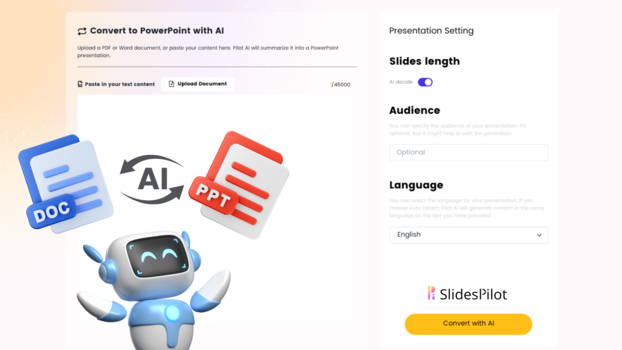
Choose from a variety of presentation template styles and select the one that best represents your content.

Relax and Watch the Magic Happen. Sit back and let AI do the heavy lifting for you! Get a customized design and stunning presentation filled with informative and professional content.
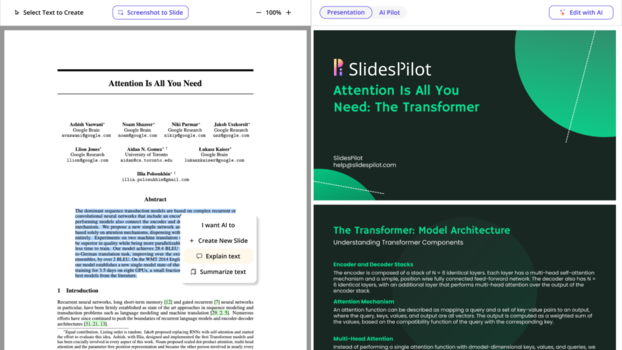
You can then edit the presentation using your preferred application, such as MS PowerPoint or Google Slides, or with our online AI Presentation Maker.
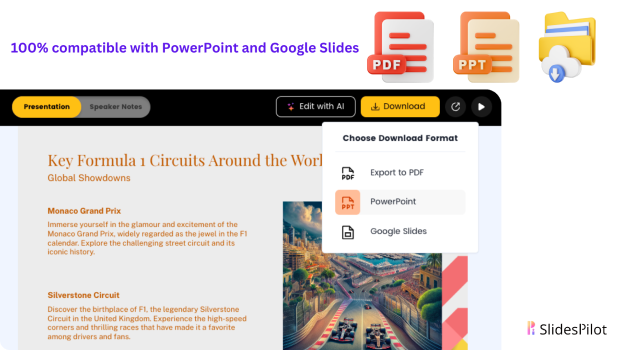
Superfast presentation creation
Join 1 million professionals, students, and educators
✓ Create with AI ✓ Convert to PPT with AI ✓ Compatible with PowerPoint ✓ Built in templates ✓ Auto Layout


How to Effectively Prepare for Your Thesis Defense

You’ve completed your research study, written your thesis, and think you’re done! If only it were this easy. Before you finish with your thesis, there is one last hurdle to overcome: the thesis defense.
What is a thesis defense?
A thesis defense is an opportunity for you to present your research study before other academic professionals who will evaluate the quality of your academic work. While a thesis defense can sometimes feel like a cross-examination in a court of law, in reality, there is no need to fear your thesis defense as long as you are well-prepared. In this article, we’ll talk about how to prepare for a thesis defense, what to expect at the defense itself, and what comes after your defense.
Why do I have to defend my thesis?
At your thesis defense, you will discuss everything you’ve learned with a group of interested examiners who are eager to hear your thoughts.
The fundamental purpose of a thesis defense is to prove that you have mastered your subject and can be considered as a knowledgeable expert in your field, thereby allowing you to graduate successfully. For many students, a thesis is one of the first attempts at conducting original research and demonstrating that you are equipped to function as an independent expert in your field. If qualified academic professionals can assess your work, question your methods and results, and confirm that your study is sound and novel, then you meet the requirements.
The exact format and expectations for your thesis defense will differ depending on the region you study in and your institution’s rules for the thesis program. The thesis defense meeting may have just two or three examiners or may have a whole panel of examiners along with an audience.
If the thought of facing your professors, peers, and parents to present your research study makes you feel dizzy, you aren’t alone . Moreover, a thesis defense is a great opportunity for you to hone your public speaking skills as well as talk about your research study. At your thesis defense, you will discuss everything you’ve learned with a group of interested examiners who are eager to hear your thoughts.
While the format for a thesis defense will vary, as mentioned above, most thesis defenses consist of:
- Presenting your research study (using PowerPoint or other similar tools)
- Answering questions from your thesis committee
- Receiving feedback from your thesis committee
So how can you prepare for it? Let’s talk about some important tips.
Preparing: Before the defense
It is useful to attend multiple defenses and ask others who have gone through the process what it was like.
The best way to prepare for a thesis defense is to attend other defenses at your institution so that you know what to expect. It is useful to attend multiple defenses and ask others who have gone through the process what it was like. Senior students are often happy to provide advice and can give you specific insights about particular examiners as well as details of the administrative process at your institution.
You should also talk to your thesis advisor well in advance of your defense about what to expect. Ask whether you need to shortlist your own committee, how long your presentation should be, and how long the thesis defense will be. The duration of a thesis defense varies by the degree level as well as the institution. On average, expect your defense to be at least an hour long, possibly longer for a Ph.D.
What should my presentation cover and how can I prepare it?
While preparing your presentation, also prepare a list of questions and answers that you think are likely to be asked by your committee.
You will need to prepare a presentation that will cover the details of your research study. It is wise to rehearse this presentation multiple times in advance of your thesis defense so that you will be comfortable when you actually present in front of your audience. While preparing your presentation, also prepare a list of questions and answers that you think are likely to be asked by your committee. If you can, enlist the help of a classmate or friend to be the examiner. They can ask you questions about your research study so you will be able to practice addressing these questions.
One mistake many students make is assuming that all members of their defense committee will thoroughly read their thesis prior to the defense. This is simply not always the case. For this reason, you should make sure your presentation makes sense to someone who has not actually read your thesis. A typical thesis defense presentation gives:
- An introduction to the topic
- Explains how the study is significant in the field
- Covers the main highlights of the methodology and results of the study
- Picks out the main points from the discussion and conclusion
What should I do the day before my defense?
Before your thesis defense, make sure you have backups of everything you need saved in multiple formats and multiple locations.
Before your thesis defense, make sure you have backups of everything you need to be saved in multiple formats and multiple locations. Put your presentation and your thesis on a USB drive, email it to yourself, upload it to the cloud, and print it out. Leave nothing to chance: you want to be absolutely prepared to defend your thesis short of an act of God obliterating the venue. In addition, make sure you prepare hard copies (printouts) of both your thesis and slideshow for the committee members. It need not be professionally bound at this stage, but they will appreciate having reference material on hand.
Finally, there are some practical steps to take in preparation for the thesis defense. Choose your outfit in advance (you should dress professionally) and practice presenting in it. You should also make sure you know the exact location of the thesis defense venue. Scope out the venue before your defense, if possible, so you can imagine yourself there while you rehearse. If you are presenting virtually, test all your equipment in advance and have a backup plan in case your internet goes out or your computer suddenly crashes. Most importantly, make sure that you eat well and get proper rest the night before. Don’t stay up late rehearsing last minute in the hopes of improving your chances of passing your defense. You will do much better if you are well-rested and alert.
Time to shine: At the defense
Try to stay calm and remember you are not on trial!
What can you expect on the day of the defense?
Typically, you will enter the room, set up, and begin your presentation once the committee indicates that they are ready. As mentioned above, it is always advisable to bring hard copies of both your thesis and slideshow for the committee. That way, they can easily refer to what you are talking about as you present. Make sure you also bring a pencil and notebook with you to take notes, and some water, because you will get thirsty as you talk.
After you are done with the presentation, the committee members will ask questions. Try to stay calm and remember you are not on trial! Your committee generally wants you to succeed, but they also want you to prove that you really know what you’re talking about. Do your best to answer their questions and never be afraid to admit when you don’t know something. It is much better, to be honest than to be caught lying or making something up during your thesis defense.
After the question and answer session, depending on your institution, you may be asked to leave the room while the committee deliberates. You may also be present while they discuss the merits of your defense and make suggestions for how to revise it. Alternatively, they might adjourn to another room if there is a large audience present. After they deliberate, they will usually thank you for your time, and your defense will be over. At some institutions, they will inform you if you passed right away, while at others, you will find out after a few days.
How does my committee decide if my work is good or not?
In general, you can expect your thesis defense and your thesis as a whole to be evaluated based on the below criteria:
- Whether the thesis meets the departmental requirements
- Whether the research study is logical and clear
- Whether the stated objectives are met in the study
- Use of primary and secondary literature
- Use of relevant and up-to-date sources
- Methodological rigor
- Your ability to critically analyze data, facts, relevant literature, and synthesize information into a coherent narrative
- Writing quality and flow
- The validity of your conclusions based on your data and analysis
- The relevance and importance of your research study in the field
- Your ability to clearly and coherently present what your thesis is about
- Your ability to answer questions about your work accurately and in-depth
- Your ability to acknowledge and consider other theories or perspectives and explain why you dismissed one theory in favor of another
In summary, the examining committee want to know:
- Did you meet the thesis criteria set by your institution?
- Did you perform high-quality research work?
- Do you know what you are talking about?
After the defense: What’s next?
After your thesis is approved, you will need to have it professionally bound and then submit copies to your university.
After your thesis defense, you should definitely celebrate and congratulate yourself for all your hard work! Unfortunately, you aren’t quite done yet. Although the committee may notify you about passing, it is also very likely that you will be asked to make some changes to your thesis before you are finally done. You should work with your advisor to finalize and incorporate any comments you received into your work as quickly as possible.
After your thesis is approved, you will need to have it professionally bound and then submit copies to your university. You will also get the chance to order copies for yourself. This process also differs by institution, so make sure you talk to the administration department to figure out what you need to do and when to complete this process.
All in all, while a thesis defense is a scary and overwhelming event, it is also an incredible achievement. Earning your degree is no small feat, and you should definitely feel proud of yourself once you have done it! Check out our site for more tips on how to write a good thesis, where to find the best thesis editing services , and more about thesis editing and proofreading services .
Editor’s pick
Get free updates.
Subscribe to our newsletter for regular insights from the research and publishing industry!
Review Checklist
To prepare for your thesis defense, make sure that you:
Find out your institutional requirements
Talk to your advisor well in advance about what to expect and prepare
Attend defenses of other students to see what they are like
Prepare your presentation early so you can rehearse it
Rehearse your presentation with a timer
Make a list of questions and answers about your research study
Enlist a friend to be the examiner and ask you questions
Prepare multiple backups of your materials (USB drive, Google Drive/Cloud storage, email, hard copy)
Have a plan for computer/internet problems if you are presenting virtually
Eat well and get a good night’s rest before the defense
Arrive at the defense venue early enough to test any IT equipment or internet connection
What should I do to prepare for my thesis defense? +
- Find out your institution’s requirements
- Attend other thesis defenses
- Speak to your advisor
- Prepare and practice your presentation
- Enlist a friend or classmate to act as the examiner and ask you questions while you practice
How long is a typical thesis defense? +
Every institution is different, but most thesis defenses are at least an hour long.
What should my thesis presentation actually contain? +
A typical thesis defense presentation introduces the thesis topic, explains how your study is significant in the field, and covers the main highlights of the methodology and results of the study. It finally picks out the main points from the discussion and conclusion section of your thesis.
What if I fail my thesis defense? +
The odds that you will fail are extremely low! Most advisors and committees do not let a candidate schedule a defense unless they feel the candidate is ready. So, don’t worry about it. However, if you do fail for some reason, your institution will have a process for you to apply to try again.
How to Write a Thesis Summary
Your thesis summary is the distilled essence of your thesis: a tool to underline the strengths of your research and make yourself recognizable as a competent scholar.

The importance of writing a good thesis summary is often underestimated and it is not too difficult to understand why. Even in the cases where a student has seriously engaged in writing his thesis, the summary is usually the last thing that gets done. The typical scenario is therefore the following: the bulk of the work has finally been done, the deadline to submit the thesis is imminent. Time is running out and, consequently, when it comes to set the summary down, this is written in a very hasty way… I am pretty sure that you can relate to this situation and – trust me – you are not the only one. Yet, this is a pity! Your thesis summary deserves to be written with a certain care for several good reasons. An effective summary is the best way to impress your readers. It will be the first thing to be read and – as hard as it is to admit – the first impression is what really counts. You should therefore think of the summary as a distilled and concentrated essence of your thesis: a tool to underline the strengths of your research and make yourself recognizable as a competent scholar.

Especially if your thesis is written in another language, setting down an accurate, compelling summary in English can be the first step to internationally disseminate your work. In this regard, keep also in mind that an English summary of your thesis may be required for a job application or a PhD-position. Having said that, how to proceed? Here you are some useful steps to write an effective summary.
Elaborate a thesis statement
The thesis statement . is the most important part. This is a sentence usually placed at the beginning of the summary and it is aimed at clarifying the main research questions of your work. The thesis statement must be clear and concise. MA theses, but also PhD dissertations, usually concern very narrow topics. So, avoid being vague and explain the central idea of your research as specific as possible. Let’s do some practical examples. A sentence like:
“the aim of the present study is to show how English skills can be improved in several ways” is certainly too vague.
Instead, a statement like:
“the aim of the present research is to show how the use of Ludwig can improve English writing skills, by providing reliable texts to get inspiration”
defines a narrower field of research. In addition, as the last example demonstrates, a good thesis statement can be enforced with further arguments.
For example, one could state that:
taking inspiration from a database of 300 million English sentences can indeed help a student to perfect their phrasing, by seeing words in the context of real sentences. A mere automatic correction tool, instead, carries the risk of worsening the student performance, for example by favouring the memorization of wrong phrases and expressions.

Explain the structure of the thesis
Each thesis is usually divided into diverse chapters, such as an introduction, a section dedicated to explaining the terminology, a chapter for the methodology, the discussion of the data, the results of the research etc. A good summary must give a clear idea of how you have organized your research step by step. So be very clear and use sentences like “in the first chapter of my thesis I treated”, “while in the second…”, “the analysis of the data has shown that” etc. And, of course, do not hesitate to use Ludwig if you need examples to take inspiration from. Keep in mind, you may have made the discovery of the century… but if you are not able to explain how you achieved such a result, you will be considered a charlatan.
How to write a thesis summary: a practical example
In this regard, it is good practice to read a number of thesis summaries and to analyse how they are written. Nowadays all the most prestigious universities offer free access to their online repositories, where one can find great inspirational models. See, for example, this website by Cambridge University. Now, let's analyse the structure of one of them:
The Italian giallo film was a type of thriller that was produced in huge numbers between the early 1960s and the late 1980s. This thesis contributes to recent scholarly attempts to situate the giallo within its socio-cultural historical context but resists the critical tendency to read these films as passive and transparent reflections of social attitudes in post-war Italy. Rather, I attend concretely to the form of these films and, specifically, to their critically neglected sound designs . I argue that the giallo’s voice tracks were conditioned by the commercial imperatives of Italy’s post-war popular film industry and that these commercial imperatives were in turn shaped by wider social, economic and political phenomena. By theorising the voice as a mediator between the giallo text and its industrial and social contexts, I show that these films both registered and reified social change. Chapter 1 demonstrates that the anonymous narrator of Mario Bava’s The Girl Who Knew Too Much (1963) adopts a range of sonorous modes throughout the film. Each of these sonorous modes invokes a specific set of intertexts which are vital to tracing both the giallo’s cultural origins and the increasingly globalised socio- cultural landscape from which it emerged. This chapter then shows that Dario Argento’s The Bird with the Crystal Plumage (1970) uses the model of the cinematic voice-over to explore the subjective experience of urban space in post-war Italy. The film suggests that by 1970 the ability to vocally ‘narrate’ and thus control space had become a fundamental assumption of the modern, cosmopolitan subject. Chapter 2 analyses Lucio Fulci’s Don’t Torture a Duckling (1972) and Sergio Martino’s Torso (1973). Both films draw on longstanding Italian cultural stereotypes to pitch the silence of the rural against the vocality of the urban. The films use silence and the voice as ‘cartographic’ tools to delineate the profound socio-economic divisions between Italy’s rural South and its more urban North, but they also illustrate the giallo’s underlying affinities with its silent cinema ancestors and so challenge the assumed temporal borders between cinematic eras. Chapter 3 argues that Argento’s Tenebrae (1982) and Fulci’s The New York Ripper (1982) variously mimic the vocal aesthetics of television. These films lay bare both the increasing dominance of the Italian cultural landscape by imported commercial television in the 1980s and the neoliberal economic project that underpinned that trend. Ultimately, they question the stability of the nation itself, precisely because the voice — now fractured across a global mediascape — is unable to signal national specificity.
The sentences in bold highlight how the author carefully organized the structure of the text. He started with a well elaborate thesis statement. As you can see, the object of the research is well defined and narrow: the study focuses on Italian thrillers , produced during a specific historical period between the early 1960s and the late 1980s. Moreover, the investigation depeens a specific aspect: the use of sounds in this movie genre. Then, the scholar explains in detail how he organized his work step by step, by summarizing the content of each chapter.

Ultimately, we can say that to write a theis summary is a less daunting task than one might imagine at first sight!
Keep in mind why and for whom you are writing
There is a huge difference between writing a summary for the theses database of your university and to write a summary for a more ambitious purpose. As mentioned above, a summary of your thesis may be required for a job application or to get a PhD position. So, if you are facing this kind of situation, you must “use” your summary in a smart way. Are there any points of contact between your thesis and the position you hope to get? If yes which ones? Is it the topic? Or, perhaps, in order to undertake your research, you have used a tool/method/program that could be pertinent with this position? So, tailor your summary in order to highlight what you need to stand out from the crowd and… good luck!
Others from Academic English

MLA, APA, Chicago, IEEE - What’s the best citation style for your paper?

The Fall of the Five-Paragraph Essay

Should I publish it in English? About the role of English in the scientific community

How to write the perfect abstract: do not displease your reviewers and get published
Subscribe to new posts.
Stack Exchange Network
Stack Exchange network consists of 183 Q&A communities including Stack Overflow , the largest, most trusted online community for developers to learn, share their knowledge, and build their careers.
Q&A for work
Connect and share knowledge within a single location that is structured and easy to search.
What is the best "last slide" in a thesis presentation?
There are some possible options as the last slide of a typical thesis presentation. I've heard of some possibilities:
A question-mark image (as the time to be slaughtered by the referees!),
A Thank You declaration (There are some negative viewpoints about these two options.),
A slide including summary of the presented ideas,
A slide reflecting the presenter's contact info (I think it does not really make sense for a thesis presenter.),
A slide including a quote (I really doubt it's the best way.),
What is the best practice to arrange the last slide, then?!
- presentation
- 8 There are probably also cultural differences to consider. In France it's customary not to thank the audience at the end of the defense -- you only thank everyone once the jury has decided to award the degree to you (or not, if they don't...). So option #2 would not be doable in France, for example. – user9646 Commented Apr 14, 2017 at 8:59
- 3 I'd finish on a one-liner that summarises what the audience should take away. Or the biggest lesson that you have learnt. – user2768 Commented Apr 14, 2017 at 14:13
- 8 Don't make it the last slide, stop at the summary, but have additional slides afterwards giving any figures or data that might be useful in answering the questions that follow. You might not need them, but they are there just in case you do. – Dikran Marsupial Commented Apr 14, 2017 at 18:40
- 55 Clearly this – David Z Commented Apr 14, 2017 at 19:34
- 3 Why Not Zoidberg? ;) Seriously though, probably a good choice is the conclusions slide... I used one on my slides that you can see here . – Andrea Lazzarotto Commented Apr 15, 2017 at 16:24
14 Answers 14
The last slide will typically be seen for some minutes after you finished talking – until you jump to some other slide for addressing a question. This is something that you should use. If you ended your talk with a summary (which is a good thing in most cases), leaving that slide gives the audience opportunity to reflect on your talk, remember what they wanted to ask a question about, or just let your central messages sink in. If they do not want to do this, but focus on the questions, they are not distracted by anything new that you didn’t talk about.
The main exception is if you find it difficult to orally convey that the talk has finished – in that case a thank you slide or an any questions? slide may be the lesser evil and save you from a few seconds of awkward silence that everybody needs to realise your talk is over. Note that you can use such a slide as a backup behind your summary slide – if you manage to finish your talk on the summary slide, the audience never gets to see it. If you botch it, you can quickly jump to the summary slide.
In most situations, however, I consider thank you slides and any questions? slides pointless, as they do not tell the audience anything new and are things that you or the chair have to say. A quote would distract the audience from the questions – unless you are going to read it, but then the quote has to really fit the occasion. Your contact information does not need an entire slide and can usually be fitted on the bottom of the summary slide.
Finally note that on some rare occasions, the following order of slides may work:
- main talk with main results
- summary and outlook
- one or two appetiser slides illustrating first steps into what you just announced as future work, e.g., to show that you paved the way for something interesting.
In this case, you can either jump back to the summary slide or stay on your last appetizer slide – depending on what is more attractive.
- 8 +1 - for everything in this (particularly noting that the 'thank you' or 'any questions' slides seem pointless unless speaker has a hard time 'closing' a talk. (And then, just flash it and get back to the summary slide so you don't leave non-content fluff up in front of audience for longer than any other slide in the talk while waiting for questions, etc. – Carol Commented Apr 15, 2017 at 14:18
- 34 @Carol I find your comment deeply unsettling . (I do fully agree with it though.) ;) – Martin Ender Commented Apr 16, 2017 at 22:22
- 6 The "any questions" slide is not only useless - it's rude. The presenter is usually not the host of a meeting - it's chair's responsibility to decide whether there is time for questions, and when it's appropriate to open the discussion. – BartoszKP Commented Apr 19, 2017 at 18:38
- 8 @BartoszKP I strongly disagree that it's rude. Even if the host has absolute authority over the structure of the meeting (which seems strange to me, especially at a defense, since presumably the speaker knows the schedule and can see the clock), the speaker is merely signaling that they are ready to take questions. – JeffE Commented Aug 18, 2017 at 2:55
- 2 @JeffE You're right, that the intent can be clear, and be a simple signal that they are ready for questions, but it looks rude, regardless of the intent. It looks like "taking over" the meeting, intruding into the position of a host. Especially at a defense, which usually is a quite formal occasion, with quite strictly defined structure and quite strictly defined rules of behaviour. – BartoszKP Commented Aug 18, 2017 at 10:00
Another alternative I have tried recently is putting thumbnails of all the previous slides on it:

It's just a recent experiment, though; I don't have enough data to tell if it's the best last slide. Apart from the eye-candy, I think it can be useful as a pseudo-summary if your slides are sufficiently recognizable (for instance, if they have pictures).
For sure it helps solving the problem mentioned in another answer: "You had this formula on one slide. Can you go back? ... No not that one, before that ... Ahh yes that one."
It's kind-of tricky to do automatically in beamer, though. You can always do it manually by copying the output file somewhere else and specifying the page numbers manually, which is how I achieved it:
- 20 Interesting touch... but don't you think it might not transfer any meaningful idea to the audience? Especially when there is a multitude of slides. So, the thumbnails will be very small and unreadable. – user41207 Commented Apr 14, 2017 at 6:36
- 14 @Roboticist Depends on your goal... If you want to transfer meaningful ideas with your last slide, this works definitely worse than a summary but definitely better than a big question mark. :) The thing I wanted to do is trying to remind the audience of the content of your talk by appealing to visual memory. Just a random thing I am trying, anyway, it's not like I have research on its effectiveness. :) If there are too many slides, you can choose to include only the "most important" ones. – Federico Poloni Commented Apr 14, 2017 at 6:43
- 11 This is great! As a bonus it provides incentive to keep presentations within a reasonable number of slides. – user1717828 Commented Apr 14, 2017 at 12:17
- 25 And if it a computer science course you should include this last slide in the thumbnails, recursively, all the way down. – Dithermaster Commented Apr 15, 2017 at 14:32
- 12 “It's just a recent experiment, though; I don't have enough data to tell if it's the best last slide” Now we are all wondering how many thesis defenses you are going to do in order to test this approach with enough data. :D – Andrea Lazzarotto Commented Apr 15, 2017 at 16:26
If I were on your thesis committee I would be most happy with your slides if they were your original work and represented your own personal tastes and sensibilities. Therefore I would be more impressed with even a goofy or weird last slide that I knew you actually came up with yourself and made sense to you, than one that was proposed to you by people on academia.se, even if it were ostensibly more professional looking or slick.
In other words, the "best last slide" is, by definition, whatever you decide it is.
And yes, I realize this is a bit of a smartass answer. I am trying to make a point here about the value of original thought, and hope that some people will find this perspective helpful or thought provoking. But to anyone who doesn't get it or thinks I am barking up the wrong tree, feel free to downvote this answer.
- 2 I actually think it's a good sensible answer. – Nobody Commented Apr 14, 2017 at 8:33
- 3 Knowing when to learn from Academia.SE is important. I'd say "designing the last slide" is one of the cases where one can learn and not reinvent the wheel. – svavil Commented Apr 14, 2017 at 23:43
- 12 @svavil if OP had framed the question as "what are some good ideas for the last slide" then I would agree that that's a reasonable thing to get advice on here. But the question is framed in a way that assumes there's a unique "best last slide", which I find off-putting. In general, many questions here seek advice on optimizing every little nuance of academic life. At some point I think it makes sense to encourage people to think for themselves. And as I said, I am more impressed by people who put personal/creative touches into their work even if the result is quirky and a little less slick. – Dan Romik Commented Apr 14, 2017 at 23:51
- @DanRomik thanks, the last comment makes your stance clearer. – svavil Commented Apr 14, 2017 at 23:52
- 3 This. My last slide was a picture of the beach I was planning to spend the next month on, trying to recover from the ordeal of writing the damn thing. It got a laugh from the audience and helped me have something to look forward to while answering the questions :) – terdon Commented Apr 17, 2017 at 21:56
In my opinion, the best last slide is a short summary of your presentation. It should contain the question you researched and what your result was. This has several advantages:
Your audience can recapitulate your talk. This allows them to better place what you told them in your conclusion and why what you did is awesome. Following the scheme "Tell them what you are going to tell them. Tell them. Tell them what you told them." makes your topic easier to understand. Since it is a graduate thesis, chances are your topic is rather complex and merits recapitulation.
This is the last slide your audience is going to see and should be the "take home message". So it can be a condensed version of what you presented, now that you explained all they need to know. This is going to fortify what the audience remembers from your talk.
A recapitulation also offers the referees prime material for slaughtering you (in the positive sense). You can keep all your used variable names, concepts, definitions, etc. on this slide so that the referees remember them. This makes asking questions so much easier and prevents question of the style: "You had this formula on one slide. Can you go back? ... No not that one, before that ... Ahh yes that one." If this is out of the way, you can directly jump to the interesting questions.
It's not anything particular to a thesis presentation, but I've found that an acknowledgement slide is a solid last slide for the presentation. It's a choice that I've found rather common from experienced presenters (e.g. visiting professors when giving seminar talks.)
I agree with others in saying that slides with just "Any Questions" or "Thank You" isn't the best. They're rather content free, and such sentiments can be handled verbally. (Also, depending on how things are handled, your advisor or committee chair may be the one to open the floor for questions and select who asks the next question, in which case it may be slightly awkward if you've already opened the floor for questions.)
Instead, you can take the opportunity at the very end of your talk to thank and acknowledge the people who have helped you out. Generally this takes the form of a photo of your advisor's group, often with a list of names of others in your group, along with several columns of names pointing out any collaborators. It's also nice to point out in a corner any funding sources, if you received any grants or scholarships which supported the work. If you put their names up in writing you don't necessarily need to read out everyones name, but it is good to point out some of the key people and potentially mention their specific contribution.
One caution is to keep the amount of talking you do on your acknowledgment slide brief. I'd recommend a minute or so at most. Spend too long - particularly with a bland recitation of 20+ names - and you'll bore the audience. If you're going to name names, pick out just a few key people whose help you'd like to highlight. Err on the side of being too brief rather than too effusive. If you have individual names up, you can acknowledge in groups ("my collaborators in the Smith Group") rather than individually.
With an acknowledgement slide you have a rather "neutral" slide that clearly signals the end of the presentation, but contains a non-trivial amount of content in itself.
Note: You didn't mention which field you were in, so I gave an answer from my experience in biochemistry. Do keep in mind that presentation styles do vary somewhat from field to field. If it's not common in your field for experienced people giving seminars to present an acknowledgement slide, please ignore my answer and pick something that's more common to your field.
- 3 While this is certainly laudable, it's also likely that this will bore at least a part of the audience. In that respect, presentations are quite a bit like movies - when the credits (that producers are ethically, and possibly even legally, obliged to show) start rolling, almost the entire audience stops watching and leaves. – O. R. Mapper Commented Apr 14, 2017 at 17:19
- @O.R.Mapper Oh, certainly. Spending too long on an acknowledgment slide is indeed terribly boring. I added in more mention of keeping it brief. -- Even then, I agree some people will "zone out". If you're lucky, they'll take the "free" time to formulate the question they want to ask you. – R.M. Commented Apr 14, 2017 at 17:36
- 5 I second @O.R.Mapper here: Any form of acknowledgement at the end of the talk is lethal to attention, enthusiasm, and flow. The only thing I consider bearable is if you just show the acknowledgement slide but do not talk about it – but then it still steals the attention of your audience. If your talk has “coäuthors”, list them on the title slide. If specific parts have collaborators, mention them on the respective slides (but only in writing). Funders can also be acknowledged on the title slide. – Wrzlprmft ♦ Commented Apr 14, 2017 at 19:19
- 3 I prefer acknowledgements up front as part of the settling-in phase. – The Nate Commented Apr 15, 2017 at 2:45
Most people won't remember where they had questions without some help. So if you want questions from the audience, end with a summary slide. And if you don't want questions, just write: "Thank you! Any Questions?"
That's how my thesis tutor described it, great advice!
- Wouldn't that be the other way around? Remind them if you want questions, and don't remind them if you don't? – timuzhti Commented Apr 17, 2017 at 6:53
- 1 @Alpha3031: That's the point, that explicitly inviting questions is not as effective as laying the groundwork for questions. – Ben Voigt Commented Apr 17, 2017 at 17:02
What I was advised to do and have seen done several times, and it worked rather well was to highlight 3-4 main pertinent points, specifically:
- brief reiteration of the research problem
- reiteration of a main aspect of the method
- a statement or 2 of the main result/outcome of the results
Underneath, I included my email address and any other main researchers - with a statement that if they wished to receive a copy of the presentation to contact by email - but check to see if this is allowed first.
(The slides before had the acknowledgements and references)
This way, while questions and/or discussion was occurring, a clear and concise summary of the presentation remained projected.
Having gone through many variations myself, more recently I settled on putting a brief bibliography on the last page. I think it is more meaningful than a "thank you" or "questions?" page (certainly more meaningful than some "inspirational" quote!), and perhaps more appropriate than contact details. Of course it does not prevent me from having a summary (if applicable) on the next-to-last page.
The bibliography need not be long; it may include references to your prior research relevant to the current presentation, or other key pieces of literature that anyone in the audience who became interested in the topic of your presentation might benefit from. (A couple of times I went overboard and had two dense bibliography pages; I don't think that was a good idea.)
I have not yet had to prepare and present a thesis but I have done a lot of presentations for my studies.
I usually use a dark background for my first slide, with the title in a light coloured font and use a light background with dark text for the presentation so my solution is to have a blank last slide with a dark background.
I usually thank the jury for their attention verbally, as a sign the presentation is finished so I do not need to thank them "in text" which feels awkward.
I also avoid the "Any questions ?" slide, especially if it is going to stay on display. I rather say something close to "If you have any question feel free to ask them I/we will do my/our best to answer them".
The reason I don't leave the summary visible too long is that I find I tend to read it over and over again when watching a presentation rather than listening to other peoples questions. If I'm like that I'm sure, or at least I hope, other are as well.
- Would the downvoter explain what's wrong with this answer? – Nobody Commented Apr 14, 2017 at 8:08
- 3 I did not downvote, but the answer is a bit unclear. Is the proposed solution simply a blank last slide? – user21264 Commented Apr 14, 2017 at 9:26
- Yes that's it. I could maybe edit my answer to make it more obious. It should be noted though that I usually have a very simple summary of the key points and/or conclusions before that blank slide. – Valentin Pearce Commented Apr 14, 2017 at 9:30
- Also, it should fit in your presentation's overall appearance, to show that it is, in a way, part of it and not just a white slide. – Valentin Pearce Commented Apr 14, 2017 at 9:32
US Military typically employs option 3 as the penultimate slide, followed by a slide asking for questions, followed by the statement or a slide "This concludes my brief" or presentation.
For the presentation of a thesis, option 3 is always good for a penultimate slide at which you can ask for questions. I'd follow that with a thank you slide to conclude.
- Interesting and practical response, thank you! – user70612 Commented Apr 15, 2017 at 15:04
- 1 @Saturnus Thanks. This is my first post on the site. I think a summary should always be included in any good conclusion, like most of us are taught in grade school. – user26439 Commented Apr 15, 2017 at 15:12
I've been at a Master thesis defence, where professor N., known for his inspiring and engaged teaching style, and admired by many students, was present. At the end of the presentation, the last slide said
Thank you for your attention!
The chairman asked whether there are questions, and as usual, there was one from N. The student answered, and then clicked to the next slide, saying
Thank you for your attention, professor N.!
This will depend largely on what happens after your presentation. If the last slide will stay on screen during discussions between the thesis committee and you, a picture representing your work (e.g. your thesis cover) might be a good choice.
How about combining option 2 and 3
Since I sometimes find it hard to round-off a presentation without creating an awkward silence, but do not like having a slide saying only "Thank you", let me offer one more alternative.
Have a last slide with a summary/conclusion of your main results, and possibly some future work. Also end the talk by quickly reiterating your main result(s). Then at the end, let the words "Thank you" (or "Questions?" or whatever you want to end the presentation with) appear at the bottom of this slide. I usually use a slightly larger font and different color, such that it stands out.
This allows you to smoothly end your presentation, yet keeps the useful summary slide on screen during the discussion.
Best way to end your presentation is to give an overview of whole things you described in earlier slides. you can also request for feedbacks for your presentation to improve according to audience point of view.
- 10 And would should be on the last slide then? – FuzzyLeapfrog Commented Apr 14, 2017 at 16:59
You must log in to answer this question.
- Featured on Meta
- Bringing clarity to status tag usage on meta sites
- Announcing a change to the data-dump process
Hot Network Questions
- What should I do if my student has quarrel with my collaborator
- Can a quadrilateral polygon have 3 obtuse angles?
- What is the difference between passing NULL vs. nullptr to a template parameter?
- Pressure of a gas on the inside walls of a cylinder canonical ensemble
- Is it safe to install programs other than with a distro's package manager?
- Can I Use A Server In International Waters To Provide Illegal Content Without Getting Arrested?
- Convert 8 Bit brainfuck to 1 bit Brainfuck / Boolfuck
- Escape from the magic prison
- Is it possible to recover from a graveyard spiral?
- Maximisation of product
- Is loss of availability automatically a security incident?
- How should I tell my manager that he could delay my retirement with a raise?
- Is it a good idea to perform I2C Communication in the ISR?
- How do I learn more about rocketry?
- Short story about humanoid creatures living on ice, which can swim under the ice and eat the moss/plants that grow on the underside of the ice
- Numbering Equations in a Closed Bracket
- How to securely connect to an SSH server that doesn't have a static IP address?
- Why didn't Air Force Ones have camouflage?
- Is there an error in Lurie, HTT, Proposition 6.1.2.6.?
- What's the benefit or drawback of being Small?
- What other marketable uses are there for Starship if Mars colonization falls through?
- Can Christian Saudi Nationals visit Mecca?
- A seven letter *
- Is there a way to do a PhD such that you get a broad view of a field or subfield as a whole?
Got any suggestions?
We want to hear from you! Send us a message and help improve Slidesgo
Top searches
Trending searches

suicide prevention
9 templates

27 templates

hispanic heritage month
21 templates

american history
85 templates

17 templates

109 templates
Master's Thesis
It seems that you like this template, master's thesis presentation, free google slides theme, powerpoint template, and canva presentation template.
The path to higher academic degrees is long, we know that, so get ready for your thesis defense and let us help you obtain that master’s that you’ve always wanted with this new template by Slidesgo.
We’re sure the first thing that you’ve noticed is the road-themed pictures in some of the slides. It’s the perfect visual metaphor for you to show how much you’ve gone through during your research. In a thesis defense, the clarity of your ideas is essential, so that’s why we’ve decided to include a simple background with no distracting elements whatsoever. The color palette combines greenish tones, synonym for confidence and personal growth, with some dynamic coral pink tones. The chosen typography provides you with a sans-serif font for the titles, giving them readability, and a slab font for body texts, giving them balance. Our theory is that you’ll achieve success with this template. What is yours?
Features of this template
- 100% editable and easy to modify
- 12 different slides
- Available in five colors: pink, blue, orange, red, and yellow
- Contains editable graphics and maps
- Includes 1000+ icons divided into 11 different themes for customizing your slides
- Designed to be used in Google Slides, Canva and PowerPoint
- 16:9 widescreen format suitable for all types of screens
- Includes information about fonts, colors, and credits of the resources used
How can I use the template?
Am I free to use the templates?
How to attribute?
Attribution required If you are a free user, you must attribute Slidesgo by keeping the slide where the credits appear. How to attribute?
Available colors.
Original Color

Register for free and start downloading now
Related posts on our blog.

How to Add, Duplicate, Move, Delete or Hide Slides in Google Slides

How to Change Layouts in PowerPoint

How to Change the Slide Size in Google Slides
Related presentations.

Premium template
Unlock this template and gain unlimited access

Create your presentation Create personalized presentation content
Writing tone, number of slides.

Register for free and start editing online

Thesis Summary
Ai generator.

Considering that you have finished writing your thesis, it is high time that you started working on your thesis summary or abstract as the last and final part of your research paper before submitting it to your instructor. Writing an abstract is actually the simplest way for your audience, the teachers and the panel of publishers (if you wish for it to be published) to know what your research paper is about without going through the bulk of your paper.
What is an Abstract?
According to an article found in the Simon Fraser University database, the abstract is deemed a critical part of your thesis and it is presented at the beginning of the thesis, as it is a summary of the whole thesis. The thesis summary is a substantive description of your work read by an external examiner by presenting all the major elements of your work in a highly condensed form.
Size and Structure
Normally, a thesis summary would only contain 120 or less (for undergraduate theses), 150 words (for Masters theses) and 350 words (for a doctoral dissertation).
- For doctoral dissertations, it is best to limit it to only 280 words with a format of one double-spaced page, to preserve visual coherence.
- The structure of the abstract should mirror the structure of the whole thesis, and should represent all its major elements.
- For instance, if your thesis has five chapters (rationale, literature review, methodology, results, conclusion), limit each chapter to only a sentence or two for each chapter in order to maximize some parts that need more substantial backing.
Clearly Specify Your Research Questions
- Research questions are important in making sure that the abstract is coherent and logically structured as they form the backbone to which other elements adhere; they should be presented near the beginning of the abstract.
- Depending on the length of your research paper, there is only room for one to three questions. If there are more than three major research questions in your thesis, try to rearrange them by reducing some to subsidiary status.
Don’t Forget the Results
- One of the most common mistakes in writing abstracts is the failure to indicate the results.
- The primary function of your thesis (and by extension your abstract) is not to tell readers what you did, it is to tell them what you discovered. Other information, such as the account of your research methods, is needed mainly to back the claims you make about your results.
- The final part of your thesis should be about summarizing your results as well as interpreting them.
- Although it is sometimes not necessary, you can choose to add keywords below your abstract as the most important terms that can be found in the thesis.
Listed below are some thesis summary examples:
This study aimed to analyze and identify the most frequent news category and rhetoric of the three local English dailies as well as assess whether they align to the readers’ news preference. These factors served as the sources of the data gathered by the researchers: ninety tertiary students, each local publication’s respective editorial board, and banner stories. Findings indicated that even though the editors would usually select their stories based on impact, the banner story content however focused more on news like crime and politics which are mostly conflict-based issues, instead of human interest stories that readers prefer the most. In conclusion, the respective editorial boards of each publication are not presenting the readers with their main interests in the banner story. Keywords: banner stories, news values, news categories, gatekeeping/gatekeepers, and readers’ preference
An example of a summary format The aim or goal or purpose of this graduation thesis (title) is to … (analyse, characterize, compare, examine, illustrate, present, survey, design, reconstruct) … The graduation thesis is composed of five chapters, each of them dealing with different aspect of … Chapter 1 is introductory and (defines, describes, reviews, deals with) … The chapter is subdivided into two parts. Part 1 describes … and explains … . Part 2 deals with … Chapter 2 examines … . The chapter consists of three parts. Part 1 focuses on … . Part 2 investigates … . Part 3 addresses the issue of … . Chapter 3 is subdivided into two parts and provides an outline of relevant … Part 1 illustrates … . Part 2 looks at … . Chapter 4 concentrates on problems resulting from … Part 1 describes …. Part 2 recommends changes to be made in legislation … Conclusions are drawn in Chapter 5. The main aim of the graduation thesis has been reached. The author suggests that …………………… should be changed/introduced/applied.
The aim of this graduation thesis entitled Development of Yamakawa Technologies to Ascertain the Existence of Cheese on the Moon is to test the use of Yamakawa technologies in ascertaining the existence of cheese on the moon. Yamakawa technologies have been successfully used to test the existence of water in Wakanda, but to date no further applications are known. For this reason the author decided to test further applications, with the aim of describing the technology’s suitability for further development. This thesis first examines the testing procedures for the water in Wakanda experiment, and presents the results. In a second stage several adaptations to Yamakawa for the testing of the existence of cheese on the moon are undertaken. Finally the technology is applied to the question of cheese on the moon, within a six-week testing phase. At the end of each week the testing apparatus is fine tuned, and experiment results are charted every twenty-four hours. The results of the experiment show that Yamakawa technologies are well suited to ascertaining the presence of water in Wakanda, but were unable to be sufficiently modified for the purpose of ascertaining the existence of cheese on the moon. The author recommends further modification to the technology before any other uses are considered.
After writing the said abstract in your research paper, then congratulations! You are now ready to move to the next step of your thesis journey, defending it. Just remember this, always know your thesis by heart. Believe me, if you do, you will not have a hard time and eventually, you will learn to enjoy it too. Good luck!
Text prompt
- Instructive
- Professional
10 Examples of Public speaking
20 Examples of Gas lighting
Have a language expert improve your writing
Run a free plagiarism check in 10 minutes, generate accurate citations for free.
- Knowledge Base
- How to Write a Thesis Statement | 4 Steps & Examples
How to Write a Thesis Statement | 4 Steps & Examples
Published on January 11, 2019 by Shona McCombes . Revised on August 15, 2023 by Eoghan Ryan.
A thesis statement is a sentence that sums up the central point of your paper or essay . It usually comes near the end of your introduction .
Your thesis will look a bit different depending on the type of essay you’re writing. But the thesis statement should always clearly state the main idea you want to get across. Everything else in your essay should relate back to this idea.
You can write your thesis statement by following four simple steps:
- Start with a question
- Write your initial answer
- Develop your answer
- Refine your thesis statement
Instantly correct all language mistakes in your text
Upload your document to correct all your mistakes in minutes

Table of contents
What is a thesis statement, placement of the thesis statement, step 1: start with a question, step 2: write your initial answer, step 3: develop your answer, step 4: refine your thesis statement, types of thesis statements, other interesting articles, frequently asked questions about thesis statements.
A thesis statement summarizes the central points of your essay. It is a signpost telling the reader what the essay will argue and why.
The best thesis statements are:
- Concise: A good thesis statement is short and sweet—don’t use more words than necessary. State your point clearly and directly in one or two sentences.
- Contentious: Your thesis shouldn’t be a simple statement of fact that everyone already knows. A good thesis statement is a claim that requires further evidence or analysis to back it up.
- Coherent: Everything mentioned in your thesis statement must be supported and explained in the rest of your paper.
Prevent plagiarism. Run a free check.
The thesis statement generally appears at the end of your essay introduction or research paper introduction .
The spread of the internet has had a world-changing effect, not least on the world of education. The use of the internet in academic contexts and among young people more generally is hotly debated. For many who did not grow up with this technology, its effects seem alarming and potentially harmful. This concern, while understandable, is misguided. The negatives of internet use are outweighed by its many benefits for education: the internet facilitates easier access to information, exposure to different perspectives, and a flexible learning environment for both students and teachers.
You should come up with an initial thesis, sometimes called a working thesis , early in the writing process . As soon as you’ve decided on your essay topic , you need to work out what you want to say about it—a clear thesis will give your essay direction and structure.
You might already have a question in your assignment, but if not, try to come up with your own. What would you like to find out or decide about your topic?
For example, you might ask:
After some initial research, you can formulate a tentative answer to this question. At this stage it can be simple, and it should guide the research process and writing process .
Now you need to consider why this is your answer and how you will convince your reader to agree with you. As you read more about your topic and begin writing, your answer should get more detailed.
In your essay about the internet and education, the thesis states your position and sketches out the key arguments you’ll use to support it.
The negatives of internet use are outweighed by its many benefits for education because it facilitates easier access to information.
In your essay about braille, the thesis statement summarizes the key historical development that you’ll explain.
The invention of braille in the 19th century transformed the lives of blind people, allowing them to participate more actively in public life.
A strong thesis statement should tell the reader:
- Why you hold this position
- What they’ll learn from your essay
- The key points of your argument or narrative
The final thesis statement doesn’t just state your position, but summarizes your overall argument or the entire topic you’re going to explain. To strengthen a weak thesis statement, it can help to consider the broader context of your topic.
These examples are more specific and show that you’ll explore your topic in depth.
Your thesis statement should match the goals of your essay, which vary depending on the type of essay you’re writing:
- In an argumentative essay , your thesis statement should take a strong position. Your aim in the essay is to convince your reader of this thesis based on evidence and logical reasoning.
- In an expository essay , you’ll aim to explain the facts of a topic or process. Your thesis statement doesn’t have to include a strong opinion in this case, but it should clearly state the central point you want to make, and mention the key elements you’ll explain.
If you want to know more about AI tools , college essays , or fallacies make sure to check out some of our other articles with explanations and examples or go directly to our tools!
- Ad hominem fallacy
- Post hoc fallacy
- Appeal to authority fallacy
- False cause fallacy
- Sunk cost fallacy
College essays
- Choosing Essay Topic
- Write a College Essay
- Write a Diversity Essay
- College Essay Format & Structure
- Comparing and Contrasting in an Essay
(AI) Tools
- Grammar Checker
- Paraphrasing Tool
- Text Summarizer
- AI Detector
- Plagiarism Checker
- Citation Generator
A thesis statement is a sentence that sums up the central point of your paper or essay . Everything else you write should relate to this key idea.
The thesis statement is essential in any academic essay or research paper for two main reasons:
- It gives your writing direction and focus.
- It gives the reader a concise summary of your main point.
Without a clear thesis statement, an essay can end up rambling and unfocused, leaving your reader unsure of exactly what you want to say.
Follow these four steps to come up with a thesis statement :
- Ask a question about your topic .
- Write your initial answer.
- Develop your answer by including reasons.
- Refine your answer, adding more detail and nuance.
The thesis statement should be placed at the end of your essay introduction .
Cite this Scribbr article
If you want to cite this source, you can copy and paste the citation or click the “Cite this Scribbr article” button to automatically add the citation to our free Citation Generator.
McCombes, S. (2023, August 15). How to Write a Thesis Statement | 4 Steps & Examples. Scribbr. Retrieved September 4, 2024, from https://www.scribbr.com/academic-essay/thesis-statement/
Is this article helpful?
Shona McCombes
Other students also liked, how to write an essay introduction | 4 steps & examples, how to write topic sentences | 4 steps, examples & purpose, academic paragraph structure | step-by-step guide & examples, get unlimited documents corrected.
✔ Free APA citation check included ✔ Unlimited document corrections ✔ Specialized in correcting academic texts
Newly Launched - AI Presentation Maker

AI PPT Maker
Powerpoint Templates
Icon Bundle
Kpi Dashboard
Professional
Business Plans
Swot Analysis
Gantt Chart
- Business Proposal
Marketing Plan
Project Management
Business Case
Business Model
Cyber Security
Business PPT
Digital Marketing
Digital Transformation
Human Resources
Product Management
Artificial Intelligence
Company Profile
Acknowledgement PPT
PPT Presentation
Reports Brochures
One Page Pitch
Interview PPT
All Categories
Top 10 Architectural Thesis PowerPoint Presentation Templates in 2024
Our Architectural Thesis PowerPoint presentations are meticulously designed, fully editable, and customizable tools perfect for students, professionals, and educators in the field of architecture. These presentations are ideal for showcasing architectural projects, research, and concepts in a visually appealing and professional manner. You can easily modify colors, text, images, and graphics to fit your unique content and personal style. Use cases for our Architectural Thesis PowerPoint presentations are vast. Students can utilize these presentations as a platform to present their thesis projects to professors, peers, or in academic conferences, demonstrating their architectural design skills, research abilities, and innovative ideas. Architects can use these presentations to explain complex architectural concepts, present project proposals to clients, or communicate design ideas to a team. Educators can use these presentations as teaching aids, illustrating architectural theories, principles, or case studies to students. They are also excellent for workshops and seminars, where the objective is to impart knowledge about the latest trends and advancements in architecture. In essence, our Architectural Thesis PowerPoint presentations are versatile tools that can enhance the way you present architectural ideas, making them more engaging, understandable, and memorable. They are not just presentations; they are a means to inspire, educate, and impress.

Sample Thesis Proposal Template Powerpoint Presentation Slides
Presenting Sample Thesis Proposal Template PowerPoint Presentation Slides that has been designed by our experts for your convenience. Customize the color, font, font size, and font type of the proposal as per your needs. Can be changed into various file formats like PNG, PDF, and JPG. It is readily available in both 4:3 and 16:9 aspect ratio. The template is adaptable with Google Slides which makes it easily accessible at once.
Thesis refers to a document that is generally submitted by a student for applying to a professional university. It is used to present the research topic and subject of study in a detailed manner. A thesis can be written on any particular subject and it is also known as a dissertation. You can explain the background of your study by using the readymade proposals. Presenting our topic-specific Sample Thesis Proposal Template PowerPoint Presentation Slides where you can write down a summary of the project for your clients. The sample dissertation proposal PPT layout comprises a table of contents that include the introduction, thesis statement, approach or methods, preliminary results & discussion, work plan, implications of research, and the list of references. You can capture the reader’s interest by providing easy-to-understand content in your proposal. In this visually-attractive thesis proposal presentation template, you can talk about the thesis statement that covers the topic like hypothesis, research questions, project, or goal statement. This will help you to capture the essence of your intended project. Employ this professionally designed sample thesis proposal PowerPoint theme to indicate the deadlines you set for completing your project research. Take the assistance of our attention-grabbing sample dissertation project proposal PowerPoint presentation slide to focus on the market components like direct beneficiaries, other beneficiaries, inputs & labor market, and political & social environment. With the help of our visually-appealing sample thesis proposal PPT slide, you can list your project stages in a table format. On the first page of your proposal, you can mention the school you are representing, your faculties, and the course of study. Included here are high-quality icons and visuals with which you can make your proposal even more creative yet professional. To make your proposal even more eye-catching, you can list down the topic which is not already known by others. Provide a brief description of the research you do by downloading our ready-to-use thesis presentation ppt templates.
- Proposal Templates

Real estate sale proposal powerpoint presentation slides
If your company needs to submit a Real Estate Sale Proposal Powerpoint Presentation Slides look no further. Our researchers have analyzed thousands of proposals on this topic for effectiveness and conversion. Just download our template, add your company data and submit to your client for a positive response.
Our Real Estate Sale Proposal Powerpoint Presentation Slides are topically designed to provide an attractive backdrop to any subject. Use them to look like a presentation pro.

Research data design ppt powerpoint presentation slides layout ideas cpb
Presenting this set of slides with name Research Data Design Ppt Powerpoint Presentation Slides Layout Ideas Cpb. This is an editable Powerpoint five stages graphic that deals with topics like Research Data Design to help convey your message better graphically. This product is a premium product available for immediate download and is 100 percent editable in Powerpoint. Download this now and use it in your presentations to impress your audience.
Our Research Data Design Ppt Powerpoint Presentation Slides Layout Ideas Cpb are topically designed to provide an attractive backdrop to any subject. Use them to look like a presentation pro.
- Research Data Design
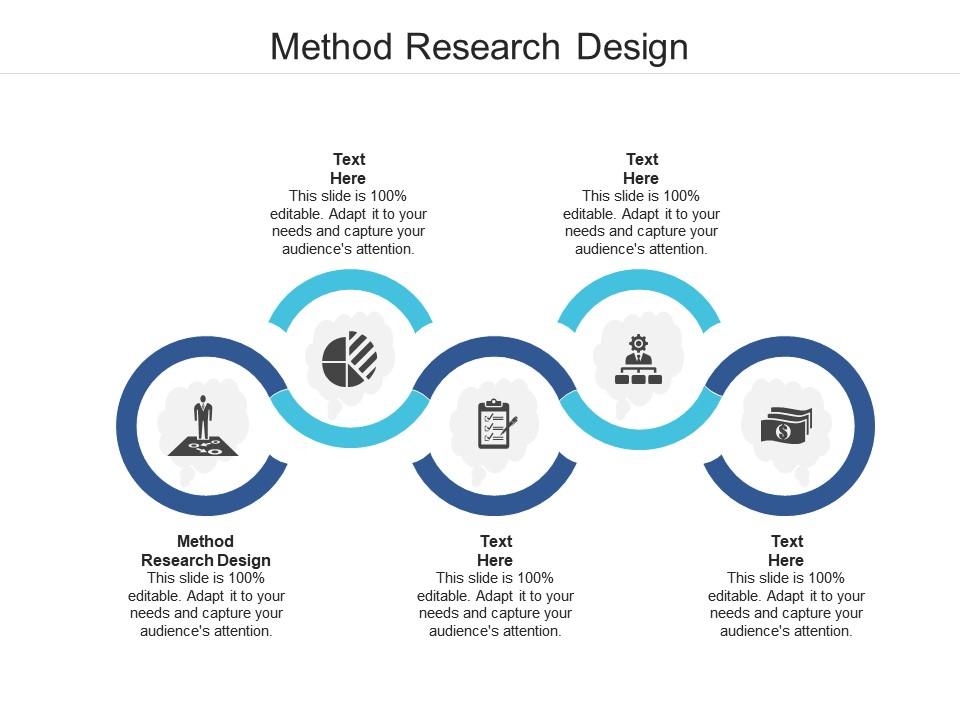
Method research design ppt powerpoint presentation pictures topics cpb
Presenting our Method Research Design Ppt Powerpoint Presentation Pictures Topics Cpb PowerPoint template design. This PowerPoint slide showcases five stages. It is useful to share insightful information on Method Research Design This PPT slide can be easily accessed in standard screen and widescreen aspect ratios. It is also available in various formats like PDF, PNG, and JPG. Not only this, the PowerPoint slideshow is completely editable and you can effortlessly modify the font size, font type, and shapes according to your wish. Our PPT layout is compatible with Google Slides as well, so download and edit it as per your knowledge.
Our Method Research Design Ppt Powerpoint Presentation Pictures Topics Cpb are topically designed to provide an attractive backdrop to any subject. Use them to look like a presentation pro.
- Method Research Design
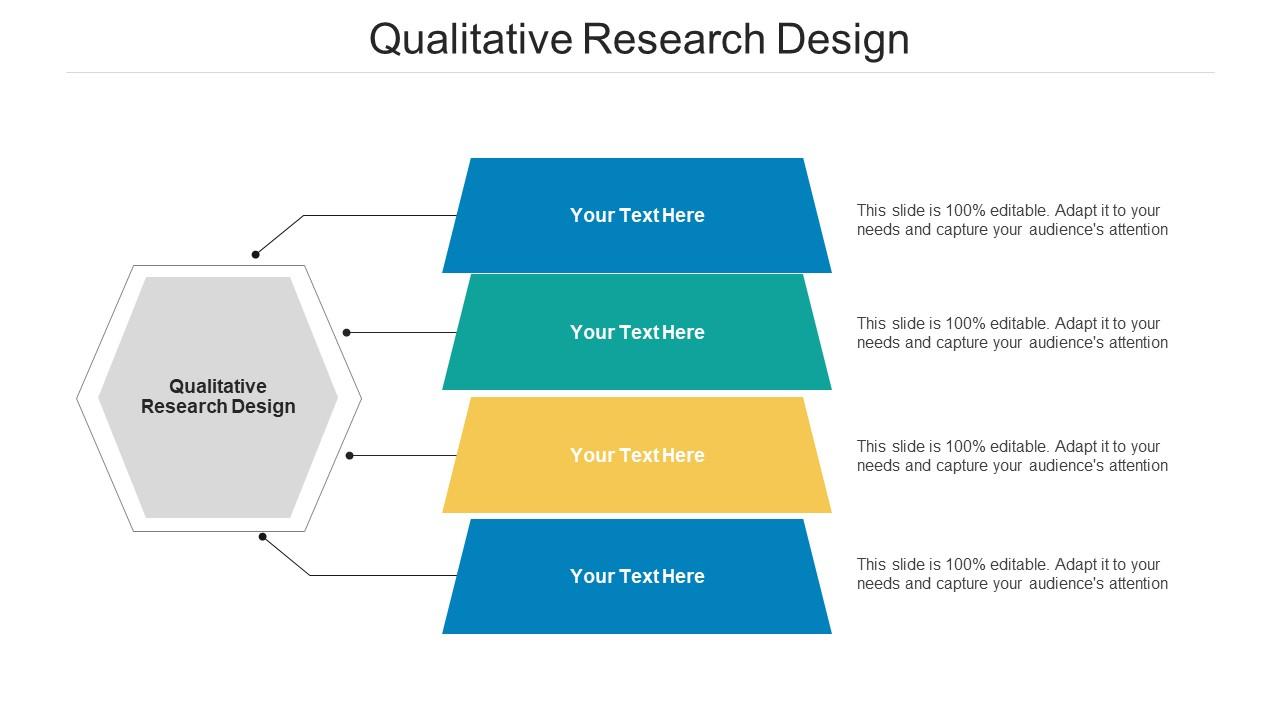
Qualitative research design ppt powerpoint presentation portfolio information cpb
Presenting our Qualitative Research Design Ppt Powerpoint Presentation Portfolio Information Cpb PowerPoint template design. This PowerPoint slide showcases four stages. It is useful to share insightful information on Qualitative Research Design This PPT slide can be easily accessed in standard screen and widescreen aspect ratios. It is also available in various formats like PDF, PNG, and JPG. Not only this, the PowerPoint slideshow is completely editable and you can effortlessly modify the font size, font type, and shapes according to your wish. Our PPT layout is compatible with Google Slides as well, so download and edit it as per your knowledge.
Our Qualitative Research Design Ppt Powerpoint Presentation Portfolio Information Cpb are topically designed to provide an attractive backdrop to any subject. Use them to look like a presentation pro.
- Qualitative Research Design
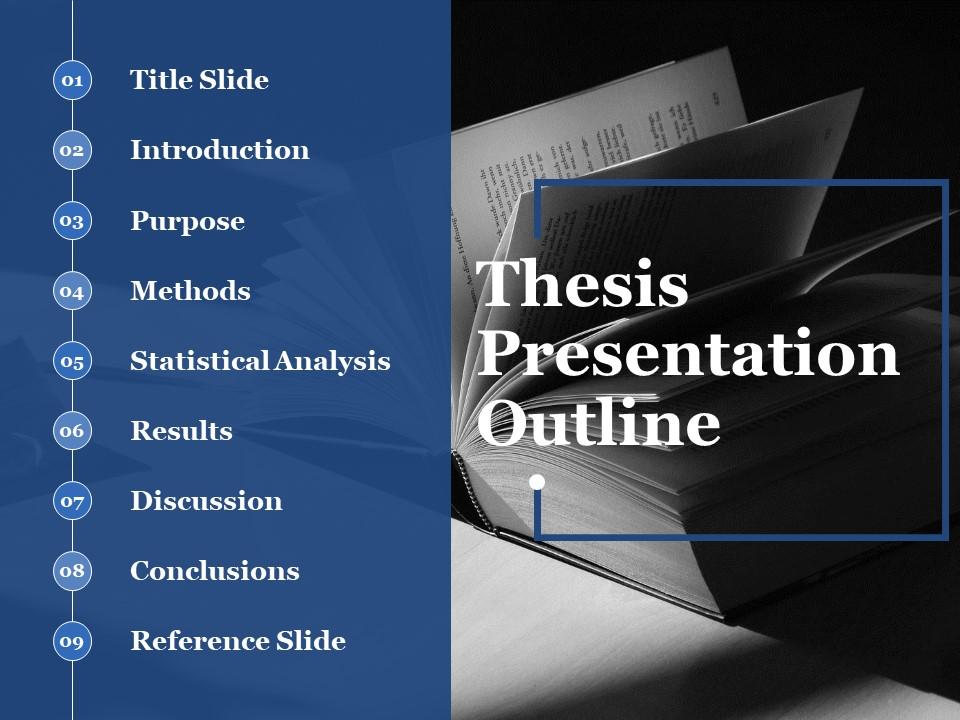
Thesis presentation outline ppt summary inspiration
Presenting this set of slides with name - Thesis Presentation Outline Ppt Summary Inspiration. This is a nine stage process. The stages in this process are Introduction, Purpose, Methods, Statistical Analysis, Results.
Force the boastful to accept their error with our Thesis Presentation Outline Ppt Summary Inspiration. Disprove any exaggerated claims.
- Statistical Analysis
- Introduction

Design research methods ppt powerpoint presentation layouts slide cpb
Presenting our Design Research Methods Ppt Powerpoint Presentation Layouts Slide Cpb PowerPoint template design. This PowerPoint slide showcases three stages. It is useful to share insightful information on Design Research Methods This PPT slide can be easily accessed in standard screen and widescreen aspect ratios. It is also available in various formats like PDF, PNG, and JPG. Not only this, the PowerPoint slideshow is completely editable and you can effortlessly modify the font size, font type, and shapes according to your wish. Our PPT layout is compatible with Google Slides as well, so download and edit it as per your knowledge.
Our Design Research Methods Ppt Powerpoint Presentation Layouts Slide Cpb are topically designed to provide an attractive backdrop to any subject. Use them to look like a presentation pro.
- Design Research Methods

Workforce research ppt powerpoint presentation summary design inspiration cpb
Presenting this set of slides with name Workforce Research Ppt Powerpoint Presentation Summary Design Inspiration Cpb. This is an editable Powerpoint one stages graphic that deals with topics like Workforce Research to help convey your message better graphically. This product is a premium product available for immediate download and is 100 percent editable in Powerpoint. Download this now and use it in your presentations to impress your audience.
Plan your support for the elderly in the community. Spread compassion with our Workforce Research Ppt Powerpoint Presentation Summary Design Inspiration Cpb.
- Workforce Research
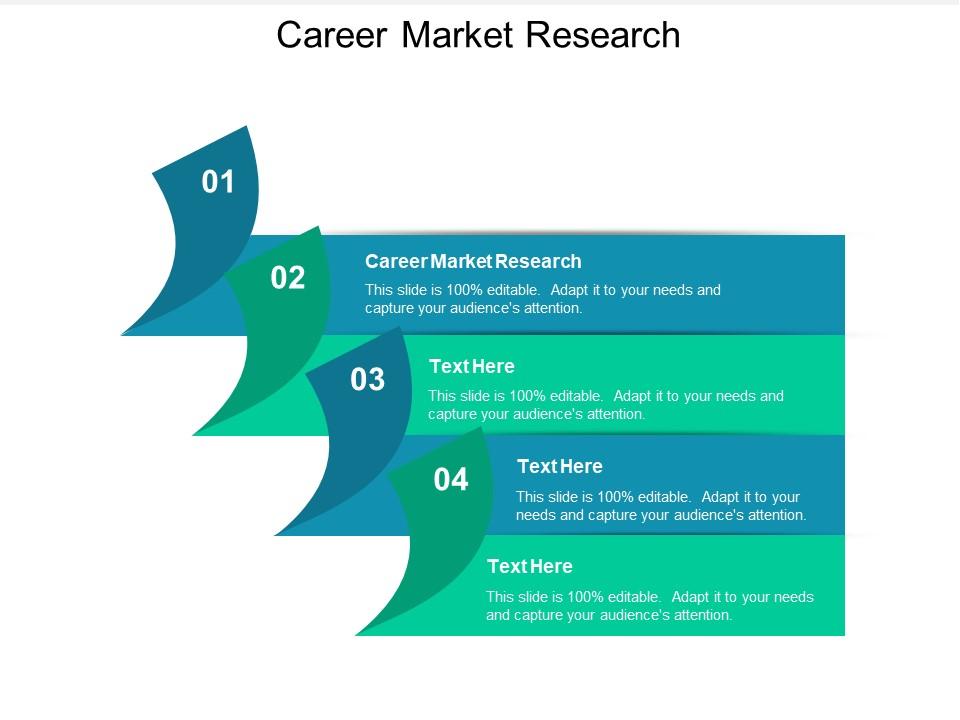
Career market research ppt powerpoint presentation ideas design templates cpb
Presenting this set of slides with name Career Market Research Ppt Powerpoint Presentation Ideas Design Templates Cpb. This is an editable Powerpoint four stages graphic that deals with topics like Career Market Research to help convey your message better graphically. This product is a premium product available for immediate download and is 100 percent editable in Powerpoint. Download this now and use it in your presentations to impress your audience.
Get folks clapping and clamoring away with our Career Market Research Ppt Powerpoint Presentation Ideas Design Templates Cpb. You will conquer the floor.

Sampling design research ppt powerpoint presentation file sample cpb
Presenting our Sampling Design Research Ppt Powerpoint Presentation File Sample Cpb PowerPoint template design. This PowerPoint slide showcases three stages. It is useful to share insightful information on Sampling Design Research This PPT slide can be easily accessed in standard screen and widescreen aspect ratios. It is also available in various formats like PDF, PNG, and JPG. Not only this, the PowerPoint slideshow is completely editable and you can effortlessly modify the font size, font type, and shapes according to your wish. Our PPT layout is compatible with Google Slides as well, so download and edit it as per your knowledge.
Our Sampling Design Research Ppt Powerpoint Presentation File Sample Cpb are topically designed to provide an attractive backdrop to any subject. Use them to look like a presentation pro.
- Sampling Design Research

Tesla: The Most Important Elements Of The Thesis
- Tesla, Inc.'s business is currently in the midst of a paradigm shift.
- To put it concisely, Tesla started as an EV company, but it is now becoming an AI and Energy company. This is its paradigm shift, so to speak.
- Today, I will walk us through the concept of “Paradigm Shifts,” which will act as the foundation for assessing the paradigm shift Tesla is experiencing.
- Irrespective of how you personally feel about Tesla, as was the case for my recent Affirm exploration, I believe these thoughts would be worth your while as a general framework.
- Looking for more investing ideas like this one? Get them exclusively at Beating the Market. Learn More »
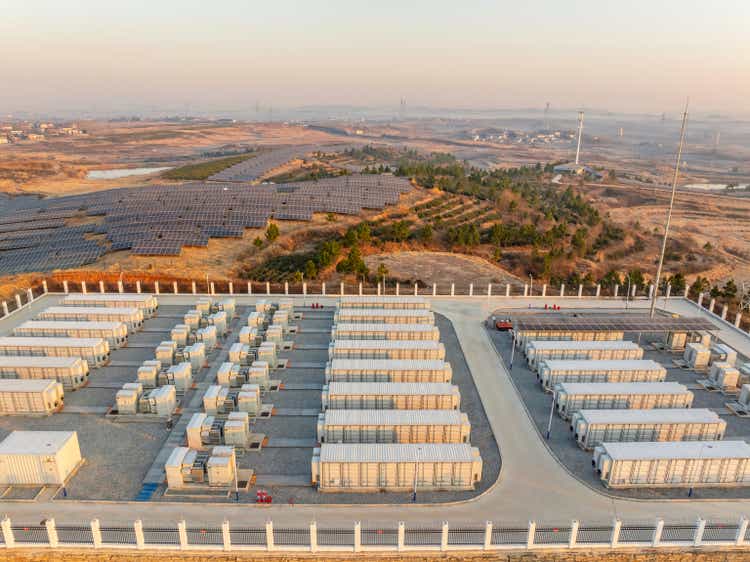
Paradigm Shifts
Like humans, businesses experience a lifecycle in which they find themselves in infantile, juvenile, adult, and elderly stages.
When a business is recently born, or launched, it requires an inordinate amount of time and attention to nurture it. Then, finally, it can stand on its own two feet, as is the case for human beings when they are born.
Over time, businesses evolve and mature, through which the perception of those businesses shifts, as is also the case for humans, in that the world's perception of us as children shifts as we age and enter adulthood.
With every business you own, there have been notable “paradigm shifts” that have followed approximately the same course I described above:
The business started out infantile and precarious, during which time much attention and care needed to be paid to it; then, it matured and developed a relative sturdiness to it, though perhaps it experienced growing pains or an ugly duckling phase; then, it reached peak productivity years, contributing to society and its shareholders at maximum levels.
And, in the same way your businesses experienced this lifecycle, we ourselves have experienced it throughout our lives.
Let's consider a couple of examples to further bring this concept to life; then, we will apply it to Tesla, Inc. ( NASDAQ: TSLA ) with a few pieces of very notable data that, I believe, will shift your Tesla paradigm, i.e., your perception of Tesla.
In 2007, Apple ( AAPL ) offered a series of hardware products and scantly much else. To this end, it was often considered a business that lacked a moat, as building a replica of the iPhone or MacBook seemed to be rather easy.
What the market missed was that the software in the iPhone would create profound moats for the business over time.
The iPhone's transition from a hardware product to a software platform was its “Paradigm Shift,” and an appreciation of this shift would have given investors greater confidence in the company's prospects.
The developer-operating system-consumer network effects for Apple's App Marketplace has served to create a virtuous cycle that gravitationally pulls the world into the Apple ecosystem. Apple's iCloud storage acts as memory augmentation for humans and creates a formidable embedding moat. Apple's blue text boxes status signal and create network effects.
In short, the paradigm shift for Apple over the last decade has been our collective perception shifting from seeing Apple as a hardware producer to seeing Apple as a hardware ecosystem. Atop of this ecosystem and within which it has embedded software products that are highly valuable.
This is just one example of a paradigm shift.
I could share with you an endless list of companies who have experienced paradigm shifts. Many of them you can read about via my profile and past ideas. I would invite you to think about the businesses you own through this lens, as well as your life and the lives of your children or spouse.
For the sake of brevity, let's now transition this discussion to a focus on Tesla's paradigm shift.
Tesla's Paradigm Shift
The argument could be made that Tesla has undergone one or two major paradigm shifts already; however, I believe it's currently in the midst of its most significant shift in the company's history, which will poise it to generate exceptional shareholder returns in the decades ahead.
I would characterize the business as roughly being a teenager or early 20s adult, and, as Blink 182's wisdom reminds us, “ nobody likes you when you're 23. ”
The Market Has Not Liked Tesla For Almost Four Years Now
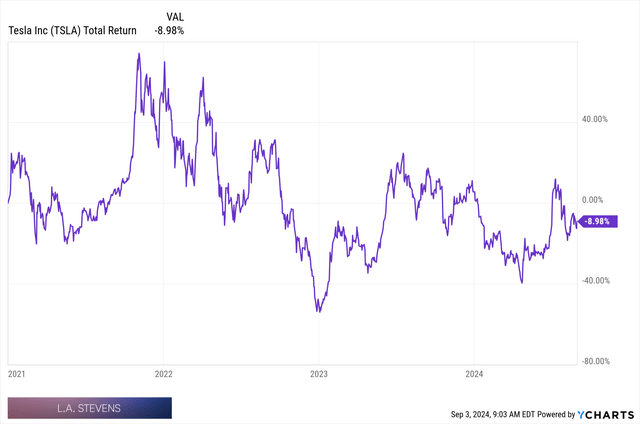
It's currently transitioning from the way its high school and college classmates saw it to the way the world will see it as a peak productivity adult, so the analogy goes.
To put this into more concrete terms, Tesla is transitioning from a hardware electric vehicle producer, prone to commoditization over time, to an EV plus AI and Energy business.
To provide concrete data illustrating this evolution, let's start with Tesla's Energy business, without which Tesla's sales would have declined in Q2 '24, instead of eking out a meager 2.3% gain year over year.
Tesla Energy Now Contributes Very Meaningfully To Tesla's Overall Sales ($3B Out Of ~$25B In Q2 '24, Up From $1.5B Out Of ~$25B In Q2 '23)

Yahoo Finance
Irrespective of how you feel about my thoughts today, you cannot deny the indisputable and concrete data presented above, in which we can see that Tesla's Energy business now operates at $12B in annualized sales scale, while growing at ~100%.
This is the reality, and it represents the business evolving from an EV pure play to an EV business that now offers genuine energy infrastructure globally as well, and materially benefits from that offering in a way investors should acknowledge.
Tesla's Energy business growth has been driven by the growth of Tesla Megapack deployments specifically, the growth of which is measured in GWh, and this can be seen below.
Tesla's Energy Business Growth Through The Lens Of GWh Deployments
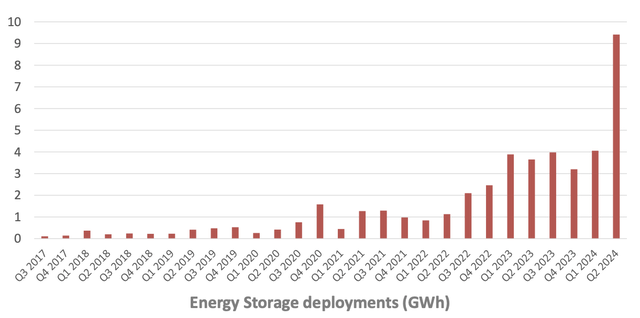
Tesla Q2'24 Earnings Presentation
In 2023, I shared a series of notes with you illustrating that this line of business was, in some sense (don't take it so literally), Tesla's “AWS.”
I did so in this article .
To a large degree, my writing to you today is just an update to that article, though with a little twist that we've already covered.
As we can see via the concrete data above, Tesla must now be considered both an EV business and a rapidly growing Energy business.
To further quantify this Energy business before we transition to Tesla's AI work and concluding thoughts, Tesla has set a goal to achieve 1,500 GWh of storage deployment by 2030. While I think this may be too ambitious, the goal seems more attainable in light of the data presented above. As shown, Tesla grew GWh deployments at 100%+ year over year and now deploys nearly 40 GWh on an annualized basis, up from just 10-15 a year or two ago.
Should it maintain this growth, then 1.5K GWh of annual deployments maybe attainable, if still very, very ambitious.
At 1.5K GWh of annual storage deployment, using the current ratio of 9 GWh/$3B in quarterly revenue, on which Tesla generates ~25% gross margins, Tesla would generate ~$500B in energy sales.
At $500B in energy sales, with ~25% gross margins, which is where Tesla's Energy margins stood in Q2 '24, I believe the company could generate between $50B and $75B in free cash flow, i.e., 10-15% free cash flow margins.
Considering the transition to an alternative energy and electric vehicle future is still in its very, very early innings, I believe that not only is this achievable, but also there will be further runway for growth after achieving it.
EV Adoption Is Still In Its Early Innings
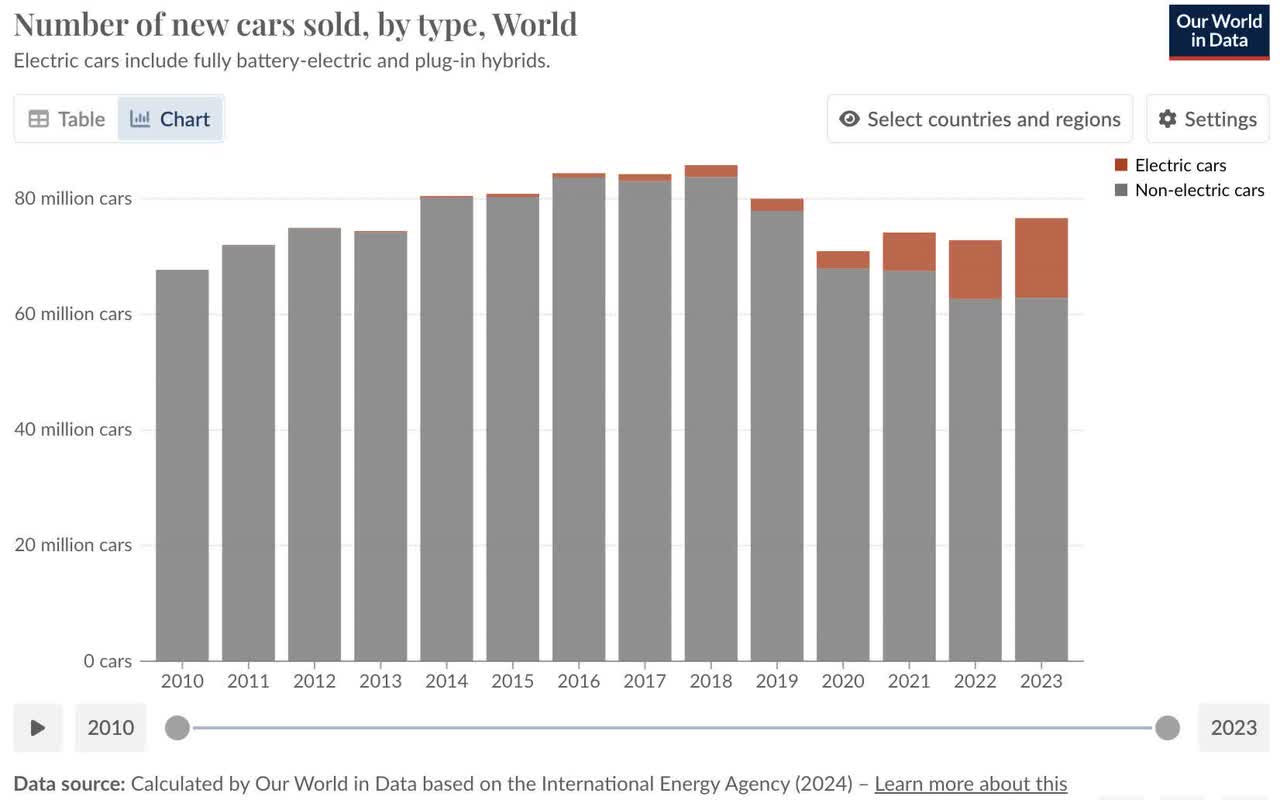
Our World In Data
But It Has Been Growing Rapidly
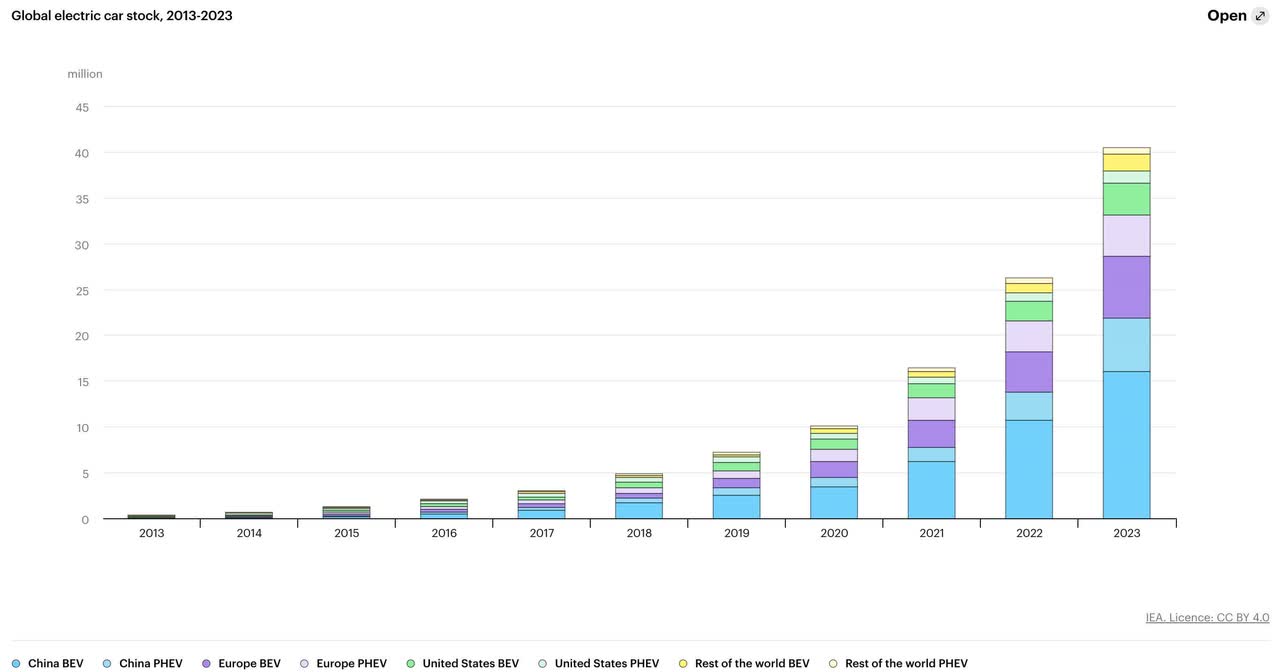
This is the first paradigm shift that is purely a matter of data. Don't shoot the messenger. Note that I use this language because I've gotten push back on highlighting Tesla's evolution, though I do not know how someone could invest in growth stocks without leveraging some forecasting of the evolution of a company's business model. There would be no sense in even commenting on Tesla today without acknowledging the possible paradigm shift underway for the business, and the same could be said for every great investment of the last 100 years:
- Apple from a computer company to an iPhone and software company.
- Amazon from a books company to a cloud computing giant
- Axon from a Taser company to a global security and software vendor
- Palantir from a government software vendor to a commercial software vendor
- Meta from Facebook company to a diversified social media conglomerate (which is now becoming a compelling AI company).
There are many, many examples of “paradigm shifts,” and they are always underway in the market. It is the process of “being” and “becoming,” and it's worth considering businesses through this lens, even if we don't get them right all the time.
Let's now turn to a consideration of Tesla “becoming” an AI company, then we will wrap up this review.
Tesla Is Becoming An AI Company
Full self-driving, or FSD, should be understood as the creation of an AI that is as smart as its biological AIs who operate vehicles on the road currently.
Tesla's FSD represents building a genuine intelligence that can reason, infer, and predict just as a human would, and, for those that use the software, and I am one of those people, you will very deeply understand this: The software interprets the movements of pedestrians, the actions of other cars, and road signs, by which it ultimately makes decisions about its maneuvers and speed.
It seems like magic, but it's actually a hardcore AI problem, which involves building genuine intelligence that is just like the biological intelligences currently on the road (over time, it will likely be better because it will not be prone to distraction or malfunction such as drunk driving).
With these ideas in mind, Tesla's FSD AI must ingest massive quantities of data, and Tesla must feed that data into giant AI compute clusters, and this Tesla has been doing.
This is similar to a child ingesting data in its early years, and developing a framework for interaction with the world over time, which allows it to survive and thrive.
Tesla FSD Miles Driven Continues To Reach New Heights
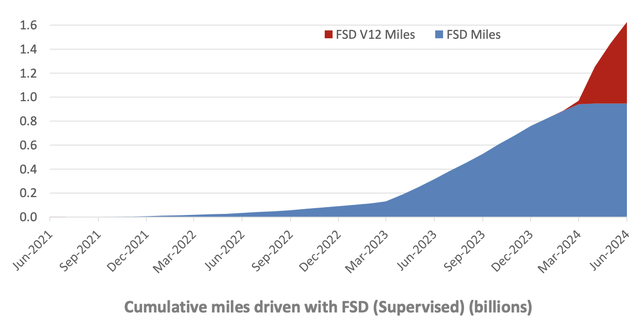
Tesla's AI Compute Capacity Continues To Aggressively Build
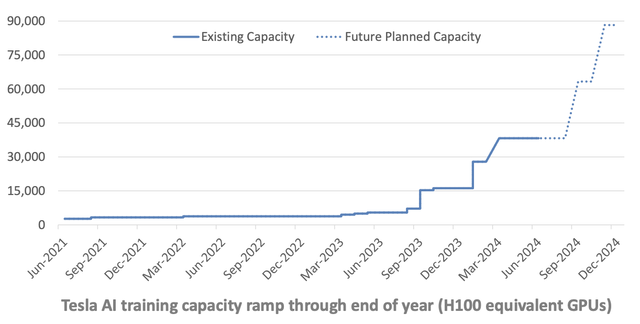
While Tesla's revenue generation from this business is objectively more nebulous than the concrete data we have on its Energy business, the training data above illustrates that there is progress being made.
Tesla's Robotaxi event will be one worth paying attention to for investors and prospective investors alike.
The concept of “Paradigm Shifts” is also synonymous with the ongoing process that we all experience of “being” and “becoming.”
At any given time, we're constantly torn between these two spectrum ends, which is a paradox of life. We're simultaneously in a state of being and becoming.
And there's risk associated with this process.
There was risk associated with Apple being a hardware produce and becoming a software producer.
There was risk associated with Amazon being a books retailer on the internet and becoming one of the most important cloud computing businesses on earth.
And, there was risk associated with Axon Enterprise ( AXON ) being a body cam and Taser vendor and becoming a global security and software vendor.
Risk lies in competition, execution, and an almost infinite series of other variables, and this could unequivocally be said for Tesla as well.
Concluding Thoughts
Whatever your perspective is on Tesla, I believe these ideas are worth pondering.
In a similar vein to my most recent Affirm article, even if you don't agree, it's worth taking time to assess these possible paradigm shifts. Consider the process of being and becoming for your own companies and for your own life.
Thank you for reading, and remember to follow for more insights such as these.
Get started with us today!
This article was written by
Louis Stevens offers a proprietary approach to equity (stock) investing.
Employing his Four Foundational Investment Frameworks, Louis purchases industry-leading businesses that possess mountainous cash hoards, robust free cash flow generation, long runways for growth, and quality company cultures.
Here is a snapshot of the performance of the companies selected using these frameworks: https://www.tipranks.com/experts/bloggers/louis-stevens
Analyst’s Disclosure: I/we have a beneficial long position in the shares of TSLA either through stock ownership, options, or other derivatives. I wrote this article myself, and it expresses my own opinions. I am not receiving compensation for it (other than from Seeking Alpha). I have no business relationship with any company whose stock is mentioned in this article.
Seeking Alpha's Disclosure: Past performance is no guarantee of future results. No recommendation or advice is being given as to whether any investment is suitable for a particular investor. Any views or opinions expressed above may not reflect those of Seeking Alpha as a whole. Seeking Alpha is not a licensed securities dealer, broker or US investment adviser or investment bank. Our analysts are third party authors that include both professional investors and individual investors who may not be licensed or certified by any institute or regulatory body.
Recommended For You
About tsla stock.
| Symbol | Last Price | % Chg |
|---|
More on TSLA
Related stocks.
| Symbol | Last Price | % Chg |
|---|---|---|
| TSLA | - | - |
| TSLA:CA | - | - |
Trending Analysis
Trending news.
- Accountancy and Control (master)
- Accountancy and Control (premaster)
- Actuarial Science (bachelor)
- Actuarial Science and Mathematical Finance (master)
- American Studies (master)
- Ancient Studies (bachelor)
- Arabische taal en cultuur (bachelor)
- Arbeidsrecht (master)
- Archaeology (master)
- Archaeology (premaster)
- Archaeology (bachelor), EN
- Archaeology and Heritage (research master)
- Archeologie (bachelor), NL
- Archival and Information Studies (duale master)
- Art and Performance Research Studies (research master)
- Artificial Intelligence (master)
- Bèta-gamma (bachelor)
- Bioinformatics and Systems Biology (master, joint degree)
- Biological Sciences (master)
- Biologie (bachelor)
- Biomedical Sciences (master)
- Biomedische wetenschappen (bachelor)
- BMS: Cell Biology and Advanced Microscopy (master)
- BMS: Cognitive Neurobiology and Clinical Neurophysiology (master)
- BMS: Developmental and Therapeutic Biology (master)
- BMS: Experimental Internal Medicine (master)
- BMS: Infection and Immunity (master)
- BMS: Medical Biochemistry and Biotechnology (master)
- BMS: Molecular Neurosciences (master)
- BMS: Oncology (master)
- BMS: Physiology of Synapses and Networks (master)
- BMS: Psychopharmacology and Pathophysiology (master)
- Boekwetenschap (duale master)
- Boekwetenschap (schakelprogramma)
- Brain and Cognitive Sciences (research master)
- BS: Ecology and Evolution (master)
- BS: Freshwater and Marine Biology (master)
- BS: General Biology (master)
- BS: Green Life Sciences (master)
- Business Administration (bachelor)
- Business Administration (master)
- Business Administration (premaster)
- Business Analytics (bachelor)
- Business Economics (master)
- Business Economics (premaster)
- Chemistry (master, joint degree)
- Chemistry (premaster)
- Chemistry: Analytical Sciences (master, joint degree)
- Chemistry: Molecular Sciences (master, joint degree)
- Chemistry: Science for Energy and Sustainability (master, joint degree)
- Child Development and Education (research master)
- Classics and Ancient Civilizations (master)
- Cognition, Language and Communication (bachelor)
- Commerciële rechtspraktijk (master)
- Communicatiewetenschap (bachelor)
- Communication and Information (duale master)
- Communication Science (bachelor)
- Communication Science (master)
- Communication Science (premaster)
- Communication Science (research master)
- Comparative Cultural Analysis (master)
- Comparative Literature (master)
- Computational Science (master, joint degree)
- Computational Social Science (bachelor)
- Computer Science (master, joint degree)
- Conflict Resolution and Governance (master)
- Conservation and Restoration of Cultural Heritage (master)
- Cultural Analysis (research master)
- Cultural and Social Anthropology (master)
- Cultural and Social Anthropology (premaster)
- Cultural Anthropology and Development Sociology (bachelor)
- Cultural Data & AI (master)
- Culturele antropologie en ontwikkelingssociologie (bachelor)
- Cultuurwetenschappen (bachelor)
- Curating Art and Cultures (duale master)
- Data Science (master)
- Data Science and Business Analytics (master)
- Data Science and Business Analytics (premaster)
- Documentaire en fictie (duale master)
- Duits, Educatie en communicatie (master)
- Duits, Educatie en communicatie (schakelprogramma)
- Duitslandstudies (bachelor)
- Duitslandstudies (master)
- Earth Sciences (master)
- East European Studies (master)
- Econometrics (master)
- Econometrics (premaster)
- Econometrics and Data Science (bachelor)
- Economics (master)
- Economics (premaster)
- Economics and Business Economics (bachelor)
- Engels, Educatie en communicatie (master)
- Engels, Educatie en communicatie (schakelprogramma)
- English Language and Culture (bachelor)
- English Literature and Culture (master)
- Entrepreneurship (master)
- ES: Environmental Management (master)
- ES: Future Planet Ecosystem Science (master)
- ES: Geo-Ecological Dynamics (master)
- European Competition Law and Regulation (master)
- European Policy (master)
- European Private Law (master)
- European Studies (bachelor)
- European Studies (premaster)
- European Union Law (master)
- Europese studies (bachelor)
- Exchange programme Economics and Business
- Exchange programme Humanities
- Exchange programme Law - Amsterdam Law School
- Exchange programme PPLE - Politics, Psychology, Law and Economics
- Exchange programme Science
- Exchange programme Social and Behavioural Sciences
- Film Studies (master)
- Filosofie (bachelor)
- Filosofie (master)
- Finance (master)
- Fiscaal Recht (bachelor)
- Fiscaal Recht (master)
- Fiscale Economie (bachelor)
- Fiscale Economie (master)
- Fiscale Economie (premaster)
- Forensic Science (master)
- Frans, Educatie en communicatie (master)
- Frans, Educatie en communicatie (schakelprogramma)
- Franse taal en cultuur (bachelor)
- Future Planet Studies (bachelor)
- Geneeskunde (bachelor)
- Geneeskunde (master)
- Geneeskunde (schakelprogramma)
- General Linguistics (master)
- Geschiedenis (bachelor)
- Geschiedenis (master)
- Geschiedenis (research master)
- Geschiedenis (schakelprogramma)
- Geschiedenis van de internationale betrekkingen (master)
- Geschiedenis, Educatie en communicatie (master)
- Gezondheidsrecht (master)
- Gezondheidszorgpsychologie (master)
- Global Arts, Culture and Politics (bachelor)
- Griekse en Latijnse taal en cultuur (bachelor)
- Hebreeuwse taal en cultuur (bachelor)
- Heritage and Memory Studies (duale master)
- Holocaust and Genocide Studies (master)
- Human Geography (master)
- Human Geography (premaster)
- Human Geography and Planning (bachelor)
- Identity and Integration (master)
- Informatica (bachelor)
- Informatiekunde (bachelor)
- Informatierecht (master)
- Information Studies (master)
- Information Systems (master)
- Interdisciplinaire sociale wetenschap (bachelor)
- Internationaal en Europees belastingrecht (master)
- International and Transnational Criminal Law (master)
- International Criminal Law - Joint programme with Columbia Law School (master)
- International Development Studies (master)
- International Development Studies (premaster)
- International Development Studies (research master)
- International Dramaturgy (duale master)
- International Dramaturgy and Theatre Studies (premaster)
- International Tax Law (advanced master)
- International Trade and Investment Law (master)
- Italië Studies (bachelor)
- Jewish Studies (master)
- Journalism, Media and Globalisation (Erasmus Mundus Master's - joint degree)
- Journalistiek en media (duale master)
- Kunst, cultuur en politiek (master)
- Kunst, cultuur en politiek (schakelprogramma)
- Kunstgeschiedenis (bachelor)
- Kunstgeschiedenis (master)
- Kunstgeschiedenis (schakelprogramma)
- Kunstmatige intelligentie (bachelor)
- Language and Society (master)
- Language, Literature and Education (master)
- Language, Literature and Education (premaster)
- Latin American Studies (master)
- Latin American Studies (premaster)
- Law & Finance (master)
- Lerarenopleidingen
- Linguistics (bachelor)
- Linguistics (premaster)
- Linguistics and Communication (research master)
- Literary and Cultural Analysis (bachelor)
- Literary Studies (premaster)
- Literary Studies (research master)
- Literature, Culture and Society (master)
- Logic (master)
- Mathematics (master)
- Media and Culture (bachelor)
- Media and Information (bachelor)
- Media en cultuur (bachelor)
- Media Studies (premaster)
- Media Studies (research master)
- Medical Anthropology and Sociology (master)
- Medical Anthropology and Sociology (premaster)
- Medical informatics (master)
- Medical informatics (premaster)
- Medische informatiekunde (bachelor)
- Midden-Oostenstudies (master)
- Midden-Oostenstudies (schakelprogramma)
- Militaire geschiedenis (master)
- Museum Studies (duale master)
- Music Studies (master)
- Music Studies (premaster)
- Muziekwetenschap (bachelor)
- Natuurkunde en sterrenkunde (bachelor, joint degree)
- Nederlands als tweede taal en meertaligheid (duale master)
- Nederlands als tweede taal en meertaligheid (schakelprogramma)
- Nederlands, Educatie en communicatie (master)
- Nederlands, Educatie en communicatie (schakelprogramma)
- Nederlandse taal en cultuur (bachelor)
- Nederlandse taal en cultuur (master)
- New Media and Digital Culture (master)
- Nieuwgriekse taal en cultuur (bachelor)
- Onderwijswetenschappen (bachelor)
- Onderwijswetenschappen (master)
- Onderwijswetenschappen (schakelprogramma)
- (Forensische) Orthopedagogiek (schakelprogramma)
- Oudheidwetenschappen (bachelor)
- P&A: Advanced Matter and Energy Physics (master, joint degree)
- P&A: Astronomy and Astrophysics (master, joint degree)
- P&A: Biophysics and Biophotonics (master, joint degree)
- P&A: General Physics and Astronomy (master, joint degree)
- P&A: GRAPPA - Gravitation, Astro-, and Particle Physics (master, joint degree)
- P&A: Science for Energy and Sustainability (master, joint degree)
- P&A: Theoretical Physics (master, joint degree)
- Pedagogical Sciences (master)
- Pedagogische wetenschappen (bachelor)
- Pedagogische wetenschappen (master)
- Philosophy (master)
- Philosophy (research master)
- Philosophy of the Humanities and the Social Sciences (master)
- Philosophy of the Humanities and the Social Sciences (schakelprogramma)
- Physics and Astronomy (master, joint degree)
- Political Science (bachelor)
- Political Science (master)
- Political Science (premaster)
- Politicologie (bachelor)
- PPLE - Politics, Psychology, Law and Economics (bachelor)
- Preservation and Presentation of the Moving Image (duale master)
- Preventieve jeugdhulp en opvoeding (schakelprogramma)
- Privaatrechtelijke rechtspraktijk (master)
- Psychobiologie (bachelor)
- Psychologie (schakelprogramma)
- Psychologie (bachelor), NL
- Psychologie (master), NL
- Psychology (premaster)
- Psychology (bachelor), EN
- Psychology (master), EN
- Psychology (research master), EN
- Public International Law (master)
- Publieksgeschiedenis (master)
- Quantum Computer Science (master)
- Rechtsgeleerdheid (bachelor)
- Rechtsgeleerdheid met HBO-vooropleiding (schakelprogramma)
- Rechtsgeleerdheid met WO-vooropleiding (schakelprogramma)
- Redacteur/editor (duale master)
- Religiewetenschappen (bachelor)
- Religious Studies (research master)
- Russische en Slavische studies (bachelor)
- Scandinavië studies (bachelor)
- Scheikunde (bachelor, joint degree)
- Science, Technology & Innovation (bachelor)
- Security and Network Engineering (master)
- Sign Language Linguistics (bachelor)
- Social Sciences (research master)
- Sociale geografie en Planologie (bachelor)
- Sociologie (bachelor)
- Sociology (bachelor)
- Sociology (master)
- Sociology (premaster)
- Software Engineering (master)
- Spaanse en Latijns-Amerikaanse studies (bachelor)
- Spirituality and Religion (master)
- Spirituality and Religion (schakelprogramma)
- Staats- en bestuursrecht (master)
- Stads- en architectuurgeschiedenis (master)
- Stochastics and Financial Mathematics (master)
- Strafrecht (master)
- Taalwetenschappen (bachelor)
- Technology Governance (advanced master)
- Television and Cross-Media Culture (master)
- Theaterwetenschap (bachelor)
- Theatre Studies (master)
- Universitaire Pabo van Amsterdam (bachelor)
- Urban and Regional Planning (master)
- Urban and Regional Planning (premaster)
- Urban Studies (research master)
- Vertalen (master)
- Vertalen (schakelprogramma)
- Wiskunde (bachelor)

Presentation Master's thesis - Jana Unterholzner - Work & Organisational Psychology
Roeterseilandcampus - Building G, Street: Nieuwe Achtergracht 129-b, Room: GS.05

IMAGES
VIDEO
COMMENTS
Consider this information as the starting point for this chat.". Step 2: Ask for an outline. With the previously provided information, ask ChatGPT to generate an outline for your presentation. If some of the points listed in the output don't convince you, then chat with the interface until you reach a final outline.
Use an appropriate language register (avoid informal language), but be approachable and natural. "Welcome to the thesis defense on [the title of your thesis]". Next, introduce yourself with your name and give a short description of your background and occupation. Don't forget to say "thank you for attending!".
2. Know Your Audience. Most people give their thesis defense presentation to an academic panel. This panel will look to see if you've developed a thorough understanding of your topic and thesis. They'll also be looking to see if you've got a solid foundation for your argument.
12 Free presentation templates for a Thesis Defense; Define your signature idea. Your thesis has a focus. A goal. A core concept. And this should be incorporated into your thesis defense presentation's design in every respect. A strong design will help to engage the committee and reinforce your expert understanding of your research area.
Deck 1: Sample PPT For Thesis Defense Presentation Slides . Template 1: Prepare Agenda for Thesis ... Introduce your topic with an attention-grabbing title slide, then go on to a summary of your study aims. Provide background information and describe your research topic or hypothesis explicitly. Create an outline of your presentation ...
A thesis presentation can be a digital summary of your research, focusing on the core knowledge in your thesis. It's short and concise. ... 8 Tips for a stunning thesis presentation. 1. Decluttered Slides. When the thesis presentation is structured smoothly, it will have the greatest impact. Overloaded slides will confuse both you and the panel.
Define your presentation's theme. 4. Design simple and focused slides. 5. Include data visualizations. 6. Practice makes perfect. Things to keep in mind to help you nail your presentation. You've reached the home stretch in your journey toward your post-graduate degree.
Purpose of the Guide. This Guide was created to help Ph.D. students in engineering fields to design dissertation defense presentations. The Guide provides 1) tips on how to effectively communicate research, and 2) full presentation examples from Ph.D. graduates. The tips on designing effective slides are not restricted to dissertation defense ...
Emphasize Core Concept: Highlight your thesis's main idea and unique contributions. Use appropriate design elements and visuals to support your message and make it understandable for a diverse audience. Smooth Transitions and Practice: Ensure logical flow between the templates and practice your presentation thoroughly.
Here are a few tips on how to prepare for your thesis defense: 1. Anticipate questions and prepare for them. You can absolutely prepare for most of the questions you will be asked. Read through your thesis and while you're reading it, create a list of possible questions.
Turning a research paper into a visual presentation is difficult; there are pitfalls, and navigating the path to a brief, informative presentation takes time and practice. As a TA for GEO/WRI 201: Methods in Data Analysis & Scientific Writing this past fall, I saw how this process works from an instructor's standpoint. I've presented my own ...
A great thesis presentation should provide the panel with a summary of your research. For that reason, try to avoid dumping too much data or information onto your slides. Use Genially's interactive infographics, diagrams and charts to highlight the most important points in an eye-catching visual format.
Join 1 million professionals, students, and educators. Create with AI Convert to PPT with AI Compatible with PowerPoint Built in templates Auto Layout. Summarize your thesis into a clear and concise PowerPoint presentation using our AI-driven tool. Convert thesis to PPT effortlessly, and leverage AI to adapt content for engaging slides.
Have a plan for computer/internet problems if you are presenting virtually. Eat well and get a good night's rest before the defense. Arrive at the defense venue early enough to test any IT equipment or internet connection. For more tips on how to write a good thesis, where to find the best thesis editing services.
Elaborate a thesis statement. The thesis statement. is the most important part. This is a sentence usually placed at the beginning of the summary and it is aimed at clarifying the main research questions of your work. The thesis statement must be clear and concise. MA theses, but also PhD dissertations, usually concern very narrow topics.
There are some possible options as the last slide of a typical thesis presentation. I've heard of some possibilities: A question-mark image (as the time to be slaughtered by the referees!), A Thank You declaration (There are some negative viewpoints about these two options.), A slide including summary of the presented ideas,
Revised on April 16, 2024. A thesis is a type of research paper based on your original research. It is usually submitted as the final step of a master's program or a capstone to a bachelor's degree. Writing a thesis can be a daunting experience. Other than a dissertation, it is one of the longest pieces of writing students typically complete.
Features of this template. Available in five colors: pink, blue, orange, red, and yellow. Includes 1000+ icons divided into 11 different themes for customizing your slides. Designed to be used in Google Slides, Canva and PowerPoint. 16:9 widescreen format suitable for all types of screens. Includes information about fonts, colors, and credits ...
Table of contents. When to write a summary. Step 1: Read the text. Step 2: Break the text down into sections. Step 3: Identify the key points in each section. Step 4: Write the summary. Step 5: Check the summary against the article. Other interesting articles. Frequently asked questions about summarizing.
An example of a summary format. The aim or goal or purpose of this graduation thesis (title) is to … (analyse, characterize, compare, examine, illustrate, present, survey, design, reconstruct) …. The graduation thesis is composed of five chapters, each of them dealing with different aspect of …. Chapter 1 is introductory and (defines ...
4 Answer to this question. Answer: A summary of a thesis is like an abstract of a research paper. Basically, the purpose of the summary is to give the reader an overview of the main points of your thesis. The summary should include the following points:
Step 1: Start with a question. You should come up with an initial thesis, sometimes called a working thesis, early in the writing process. As soon as you've decided on your essay topic, you need to work out what you want to say about it—a clear thesis will give your essay direction and structure.
Thesis presentation outline ppt summary inspiration. Presenting this set of slides with name - Thesis Presentation Outline Ppt Summary Inspiration. This is a nine stage process. The stages in this process are Introduction, Purpose, Methods, Statistical Analysis, Results.
Summary. Tesla, Inc.'s business is currently in the midst of a paradigm shift. To put it concisely, Tesla started as an EV company, but it is now becoming an AI and Energy company.
Preservation and Presentation of the Moving Image (duale master) Preventieve jeugdhulp en opvoeding (schakelprogramma) Privaatrechtelijke rechtspraktijk (master) ... Presentation Master's thesis - Jana Unterholzner - Work & Organisational Psychology. Laatst gewijzigd op 05-09-2024 18:13. share.